Google has a suite of free tools, tests, and reports to help site owners and SEO professionals analyze and improve their website’s search performance.
We’ll cover the eight best Google SEO tools so you know what they do and how and why to use them.
1. Google Search Console for Technical SEO
Google Search Console (GSC) is a free SEO tool that allows you to track your site’s health and performance. You use it to help improve your visibility and ranking in the search engine results pages (SERPs).
For example:
You could use it to track metrics that detail your search traffic changes. That way, you know which strategies are working and which aren’t.
Here’s what one of your reports could look like:
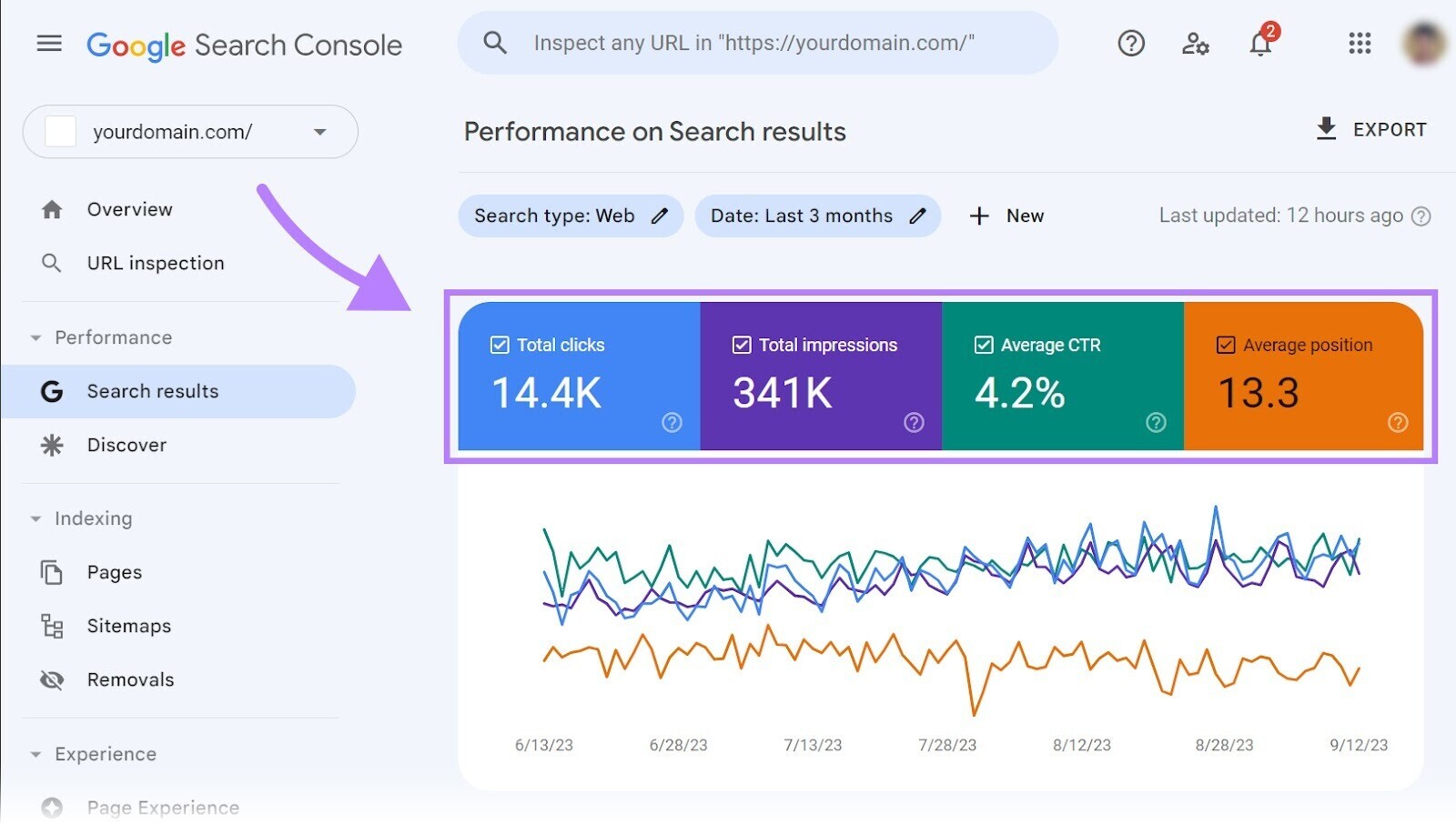
You want to improve these numbers to get more organic traffic from Google. Because more traffic means more leads and conversions. In other words, more sales and signups.
As a byproduct, you may find it gets you more traffic on Bing and other search engines, too.
What You Can Use Google Search Console For
You can use Google Search Console to:
- Understand how your site is performing on Google
- Review the pages that Google can already find and index
- Submit your sitemap and individual URLs for crawling and indexing
- Identify technical SEO issues to optimize your website
To set up GSC, sign in to Search Console with your Google account. The first time you log in, you’ll see this pop-up:
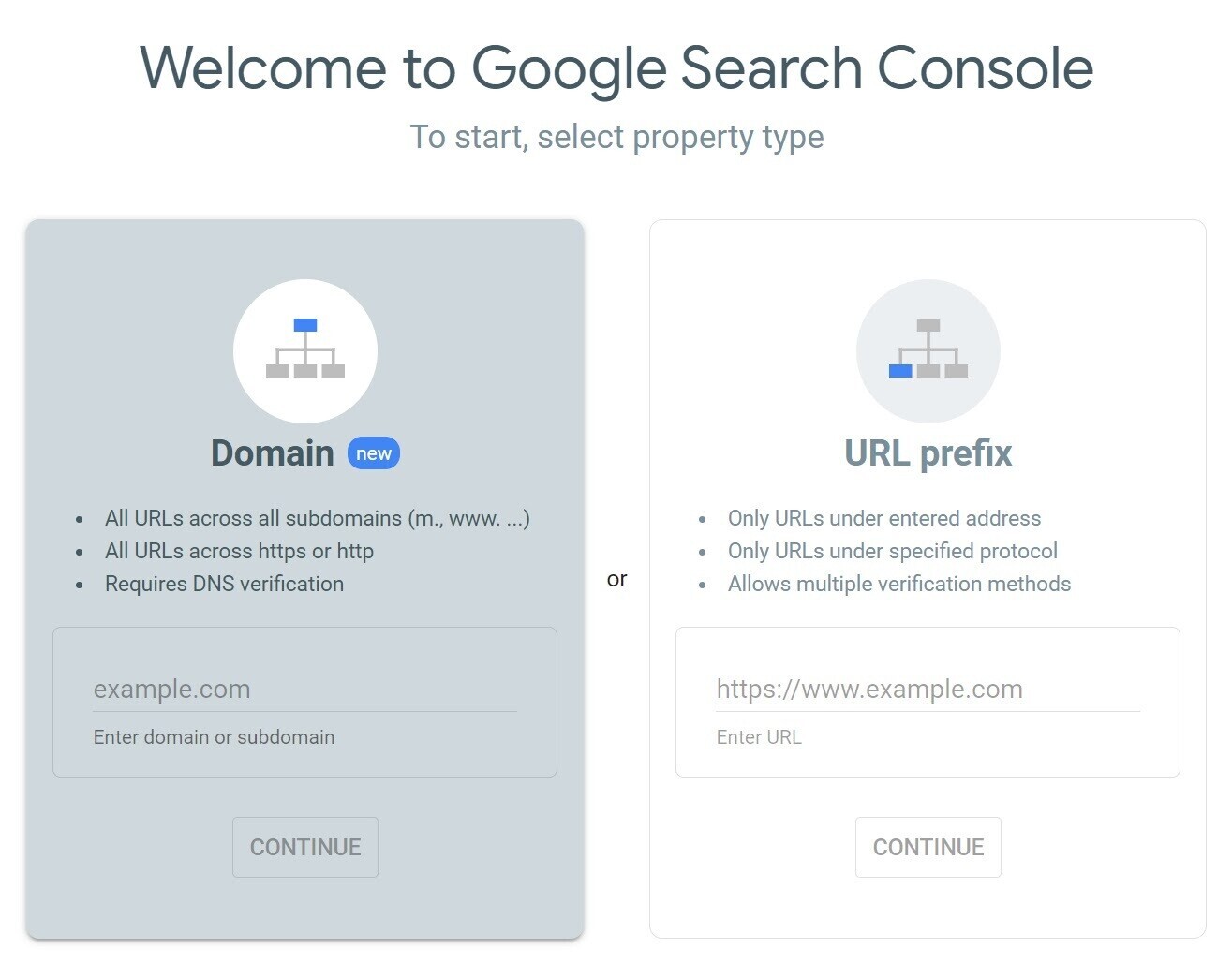
Choose between two options: Add a domain or a URL prefix. Follow the steps in our guide to understand each route in more detail.
Next, you can connect GSC to your SEO dashboard. You’ll see this interactive graph showing total clicks, total impressions, average click-through-rate (CTR), and average ranking position:
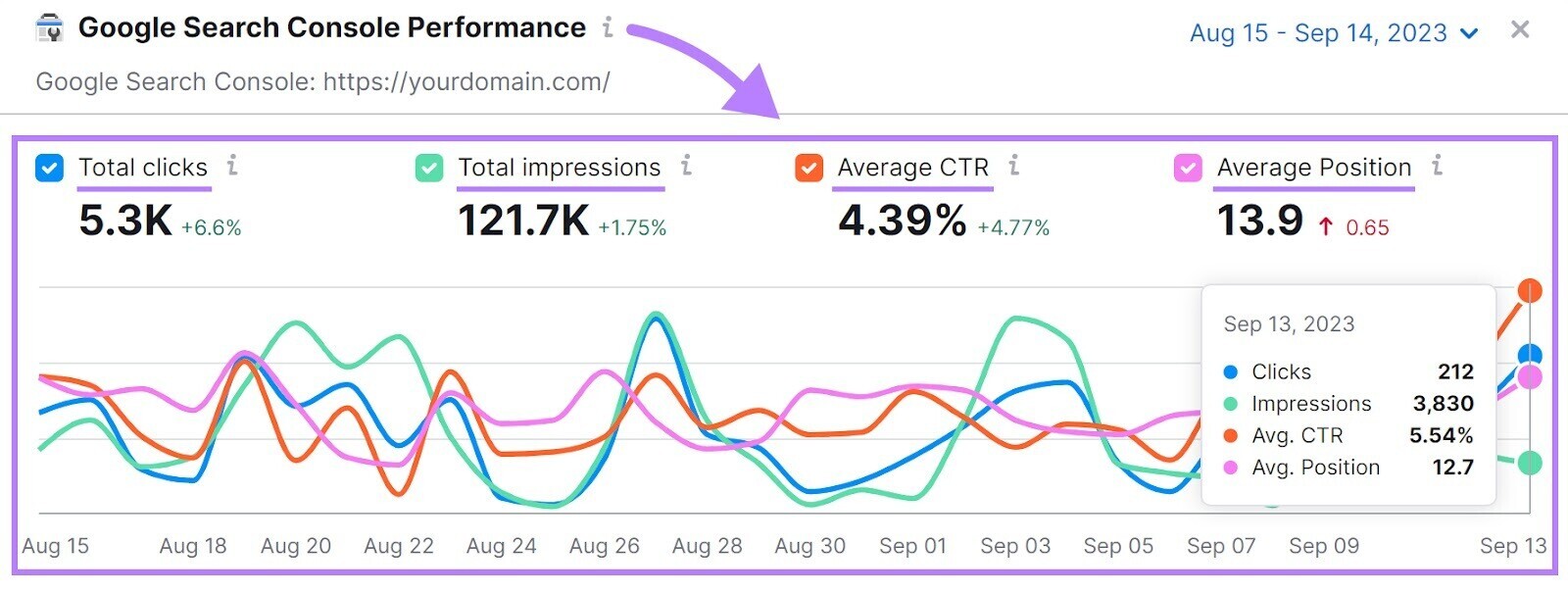
That way, you can access your site’s relevant SEO metrics and insights in one central location.
2. Google Analytics for Website Performance
Google Analytics 4 (GA4) is a free analytics platform that tracks your site or app’s performance. Think metrics like bounce rate or dwell time.
You can use these analytics reports to better inform your digital marketing efforts and SEO priorities.
Here’s what your GA4 dashboard could look like, with metrics such as new users and event count:
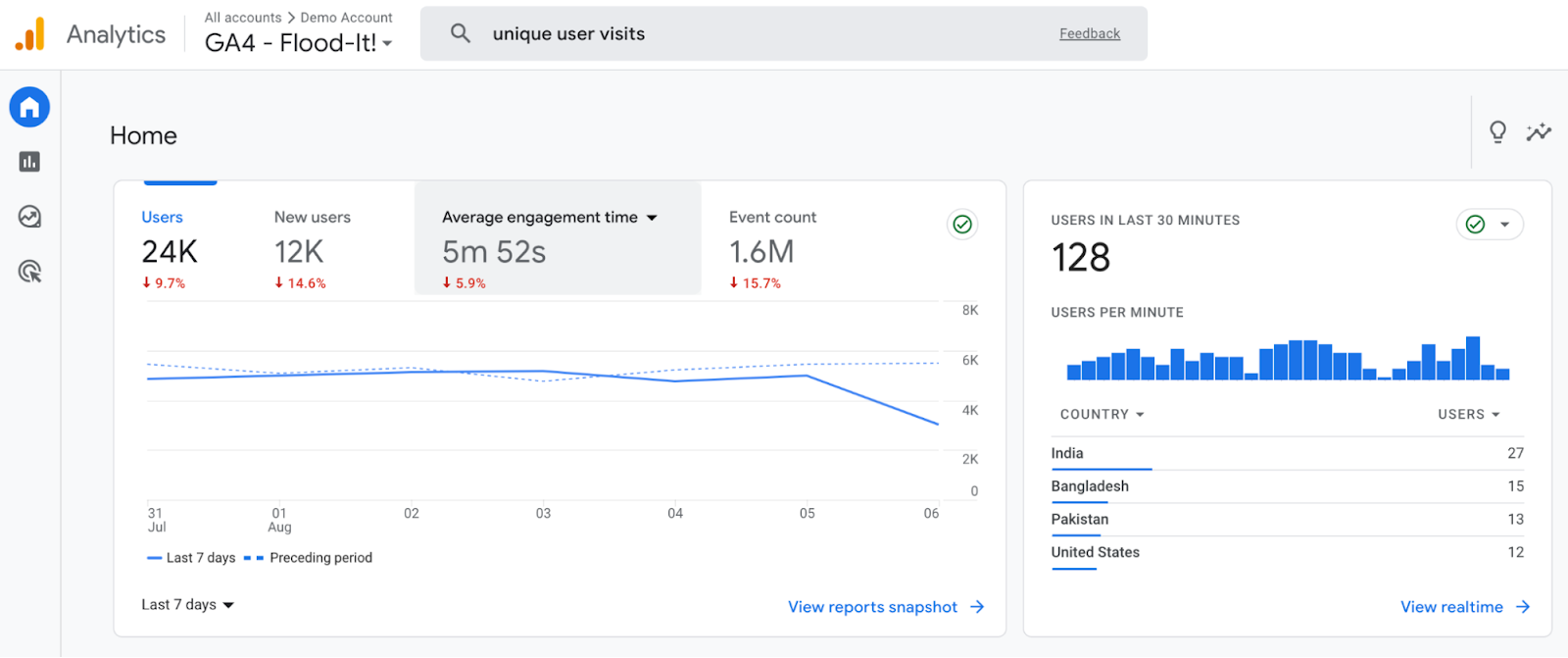
Note: This screenshot is from a demo account you can access here.
If Google Search Console is search engine-focused, Google Analytics is user-focused.
The metrics will reveal how easy your site is to navigate. In other words, it gauges the quality of its user experience (UX).
What You Can Do with Google Analytics
Google Analytics works in three stages:
- It collects your website data
- It processes that data
- It generates a report
Use these data-driven reports to spot problems and inform future SEO decisions.
How?
One way is to understand which pages are bringing in the most traffic. Then, refine the process when adding new pages.
Log in to your Google account, then head to the Google Analytics homepage. Click “Get started today” in the top right corner.
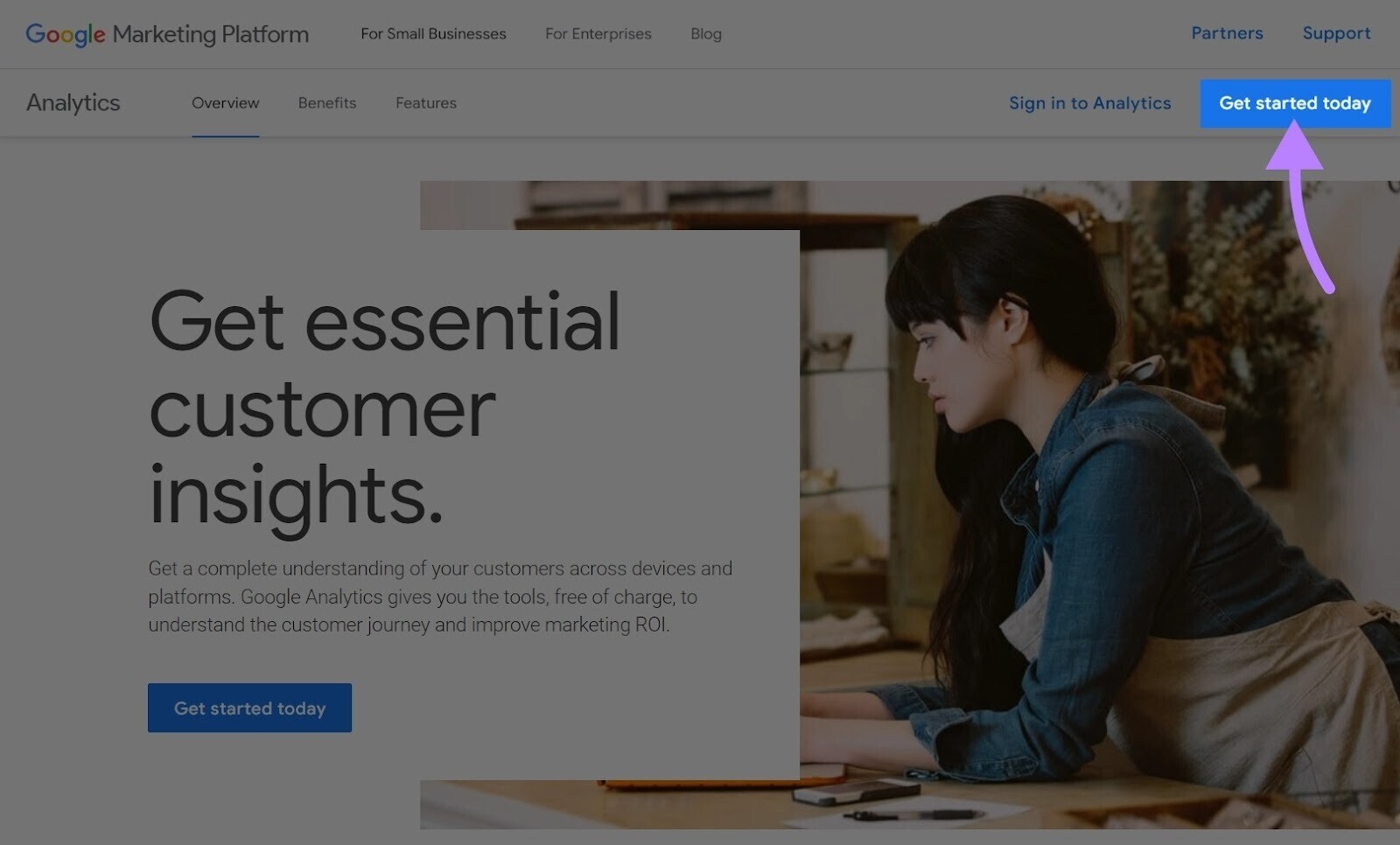
Follow the steps in our guide to complete the next three sections and create your GA account. This will differ depending on your content management system (e.g., WordPress).
Once you’re done, you can access all your important site metrics like new users and average engagement time.
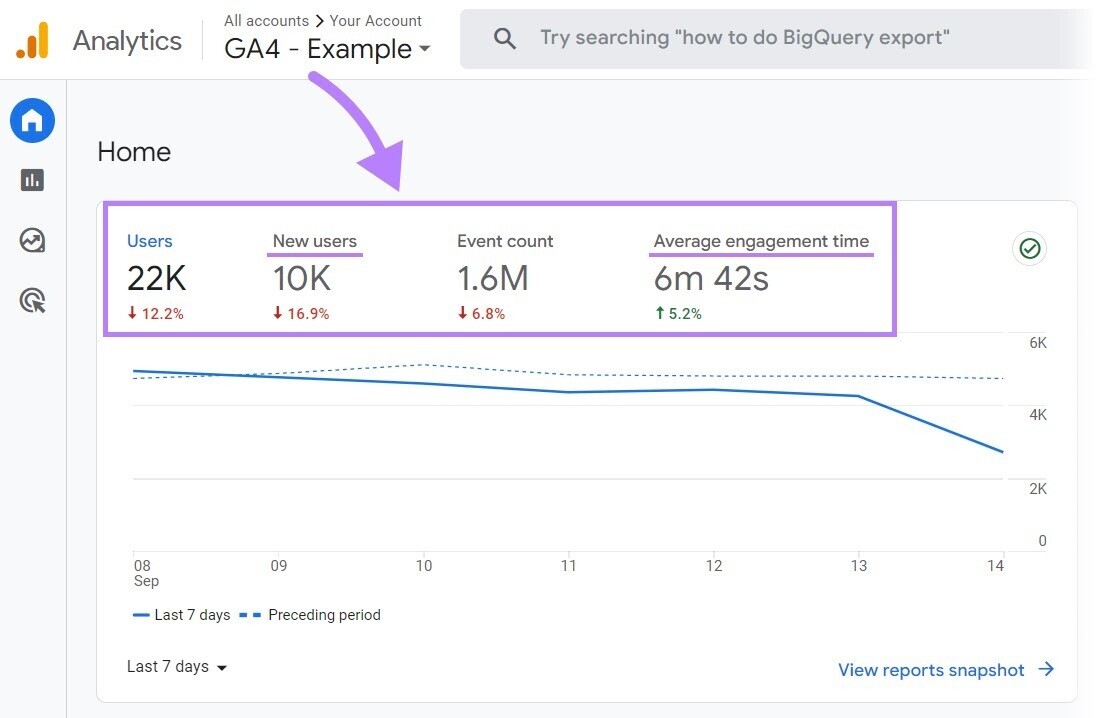
Now, head over to another of the best SEO tools out there:Semrush’s On Page SEO Checker.
As with GSC, you can add Google Analytics to your SEO Dashboard to view all your metrics in one place.
Integrate GA to leverage insights and spot potential page or UX issues. Or get in-depth advice for updating your on-page content, title tags, and internal links.
Further reading: Learn about the tags you need for GA to collect data using Google Tag Manager.
Let’s look at how you can improve on-page content to benefit your UX.
Start by configuring the On Page SEO Checker for your site. After setup, you’ll see a page like this:
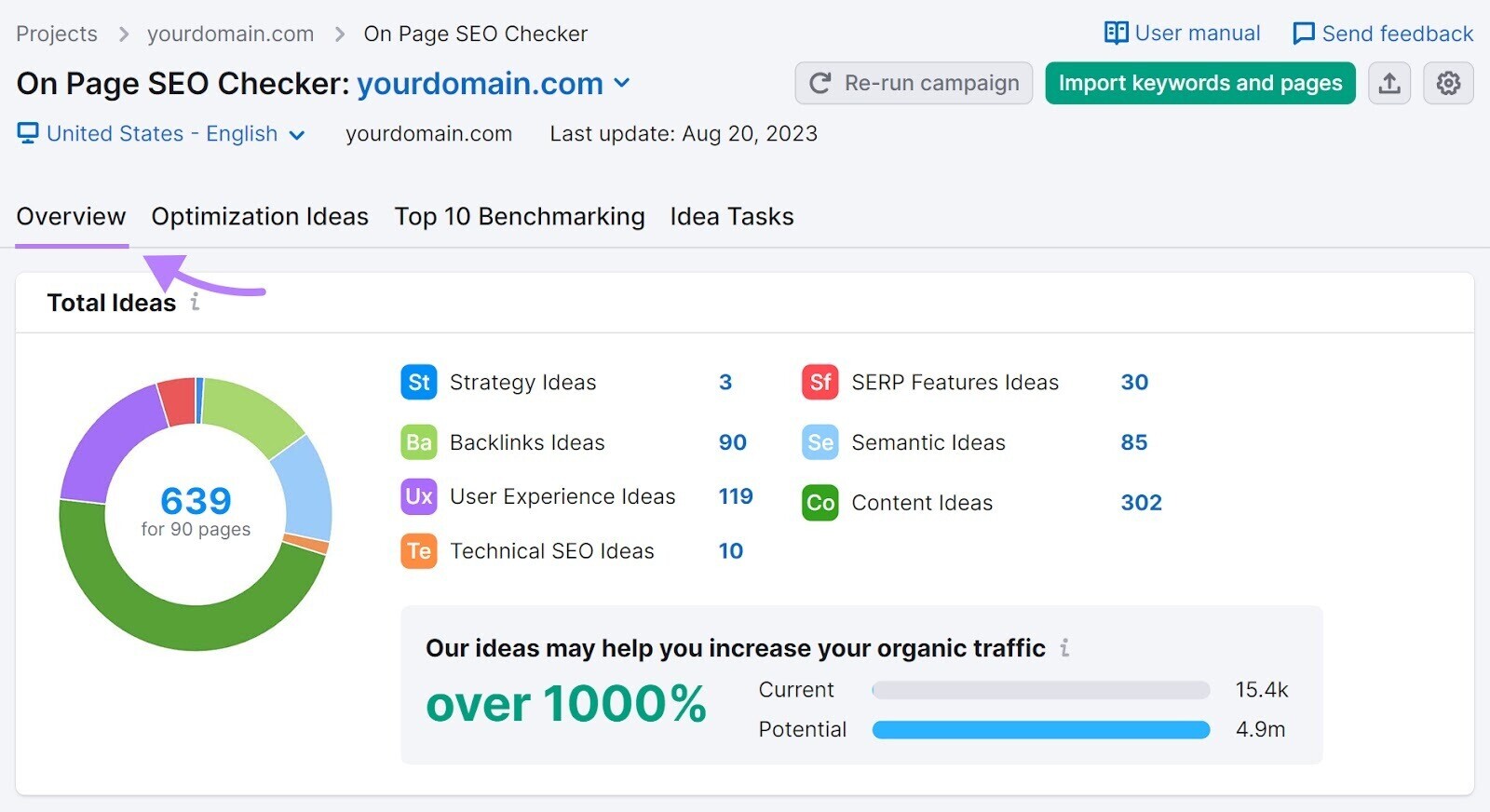
Click the “Optimization Ideas” tab to see which pages you need to prioritize.
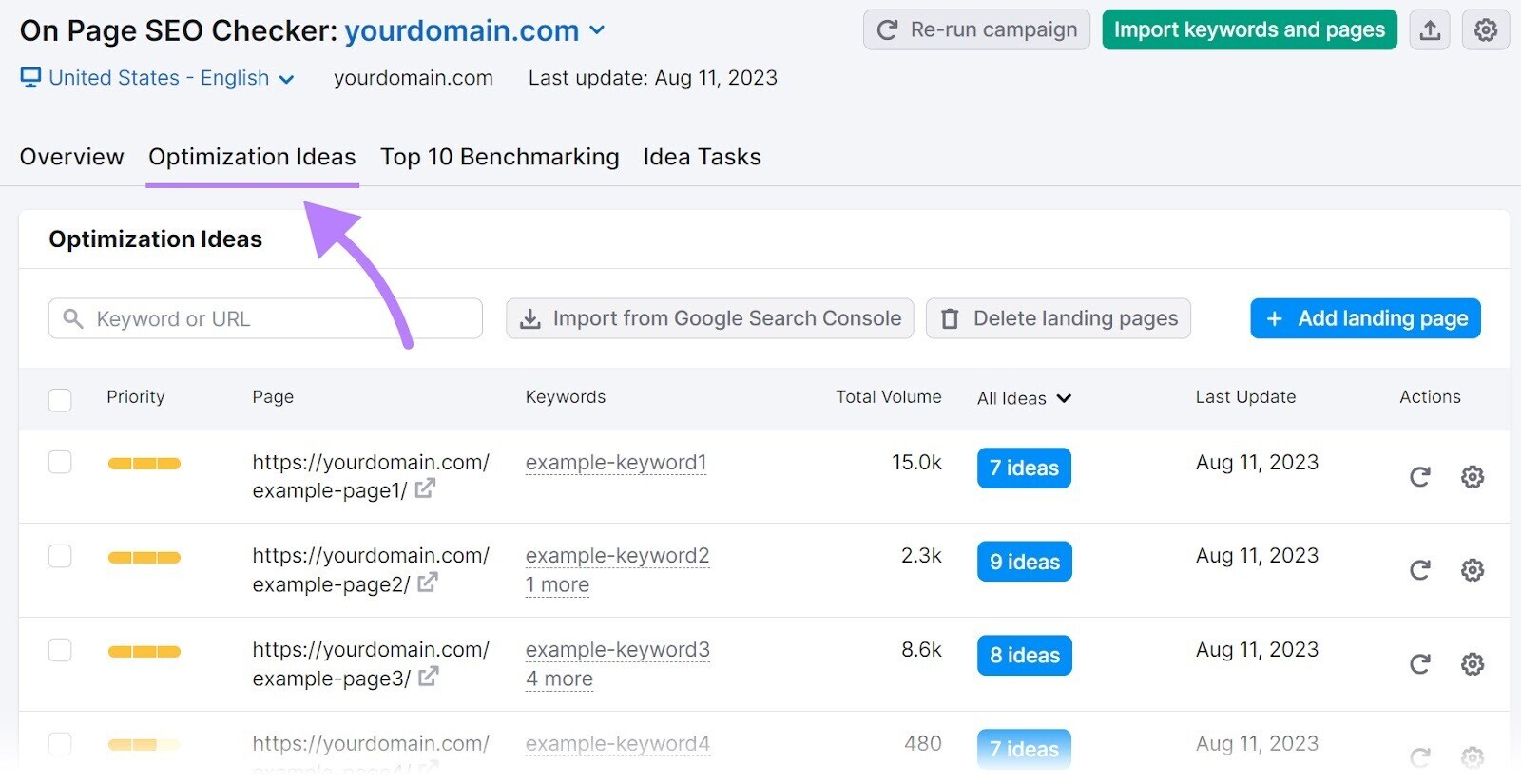
For each page, click the “X ideas” blue button to see optimization recommendations.
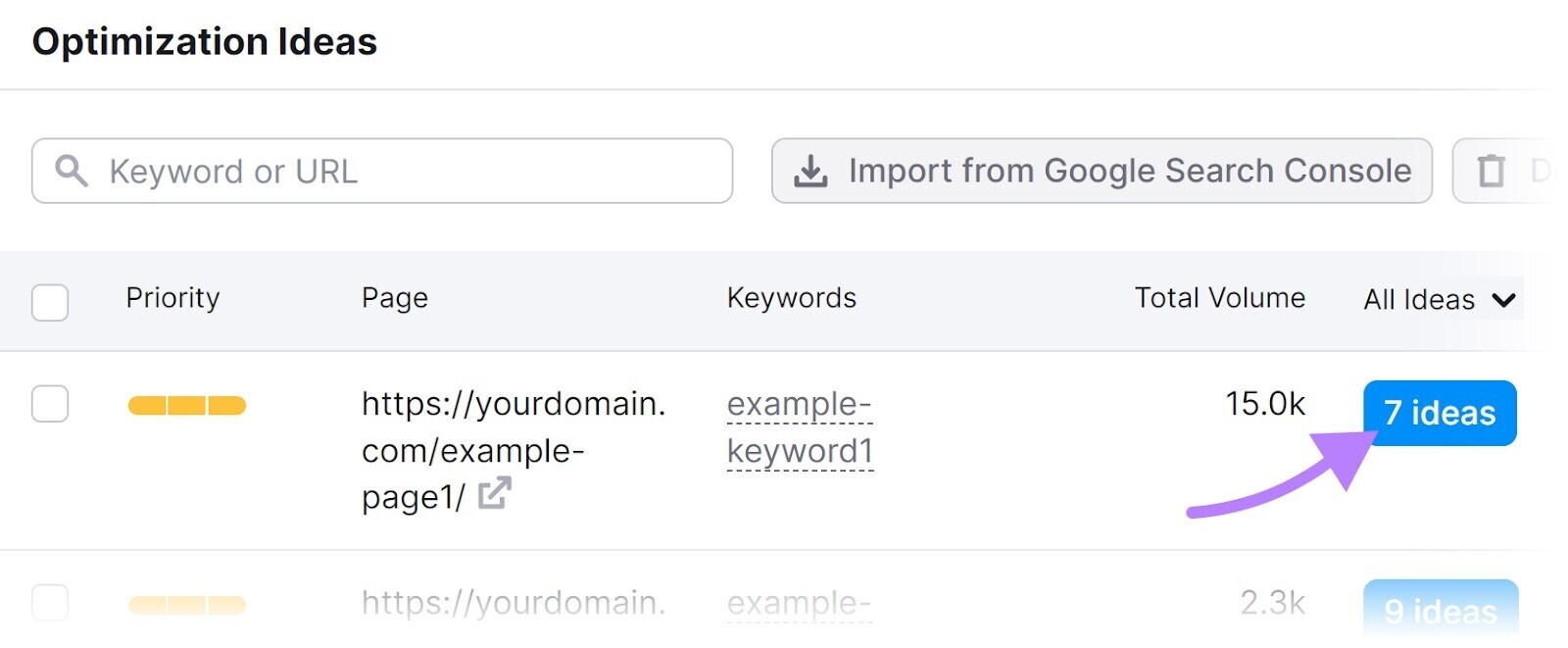
The content section will highlight your use of target keywords. (We’ll cover the importance of these a little later.)
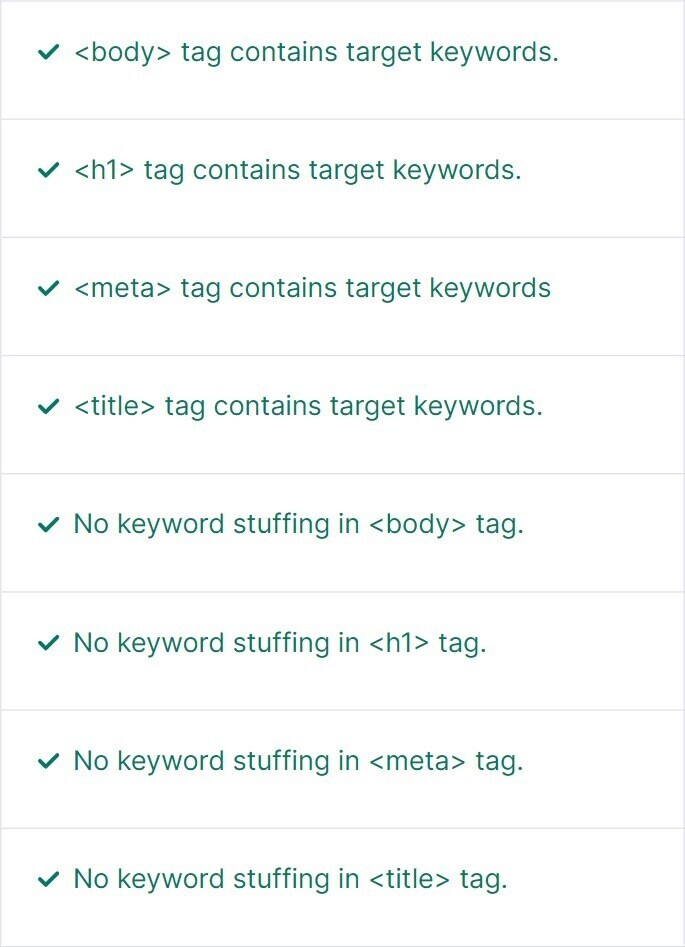
For any issues, the tool will provide recommendations. For example: “Provide a more relevant title.”

Plus suggestions for related (semantic) keywords for deeper optimization—like the ones in the below list:

Once you’ve reviewed your content, use the On Page SEO Checker to improve your title tags, meta descriptions, and headings.
To ensure you optimize your website’s performance and provide an excellent experience for visitors.
3. Google Business Profile for Local SEO
Google Business Profile (GBP) is a free local SEO tool that influences your company’s appearance on Google Search, Maps, and Shopping.
What Can GBP Do?
Use your GBP to:
- Increase local visitors (thanks to higher SERP visibility)
- Get more reviews to gain credibility
- Share business information with customers
Here’s an example of local Google search results:
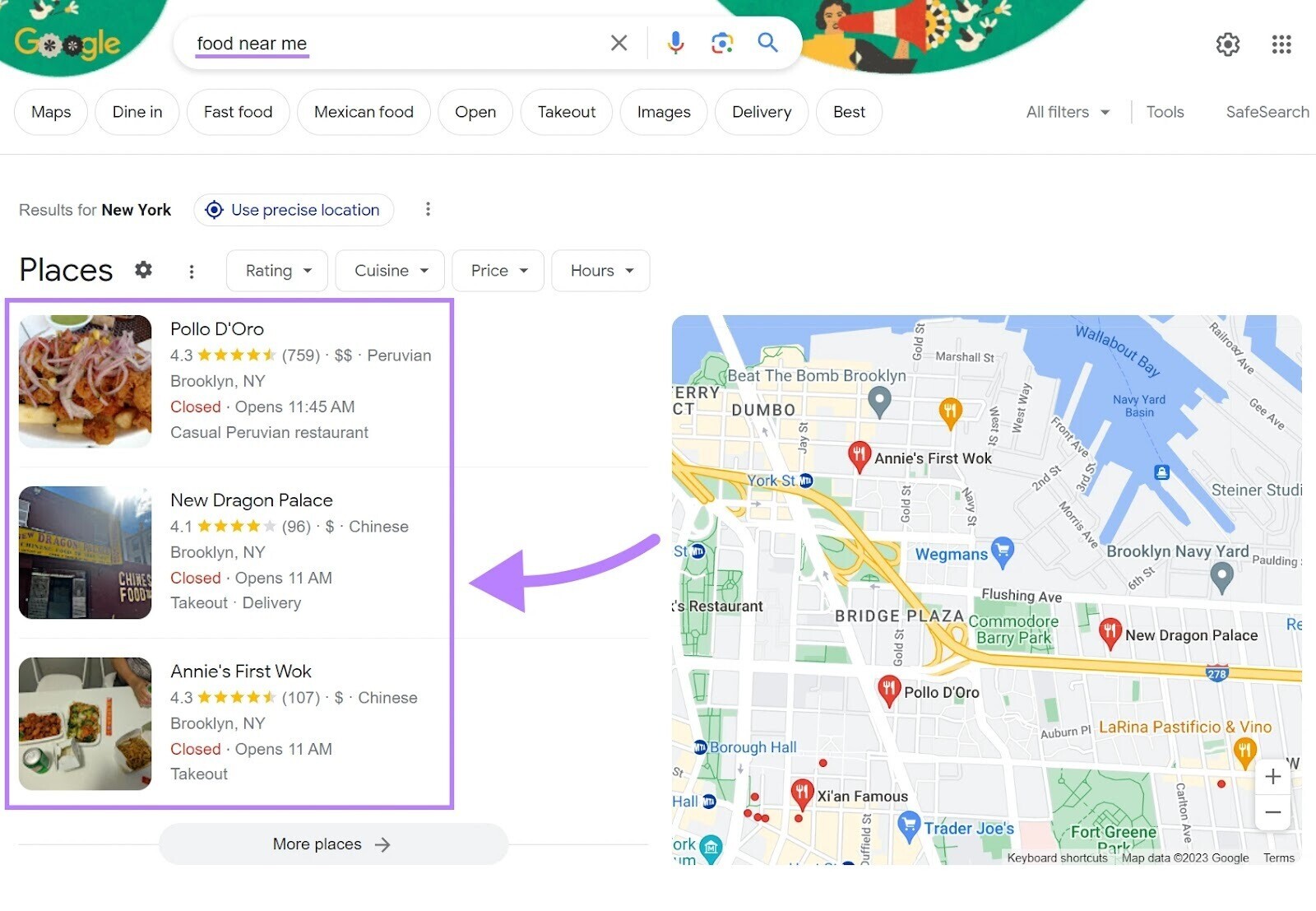
And this is what a GBP looks like:
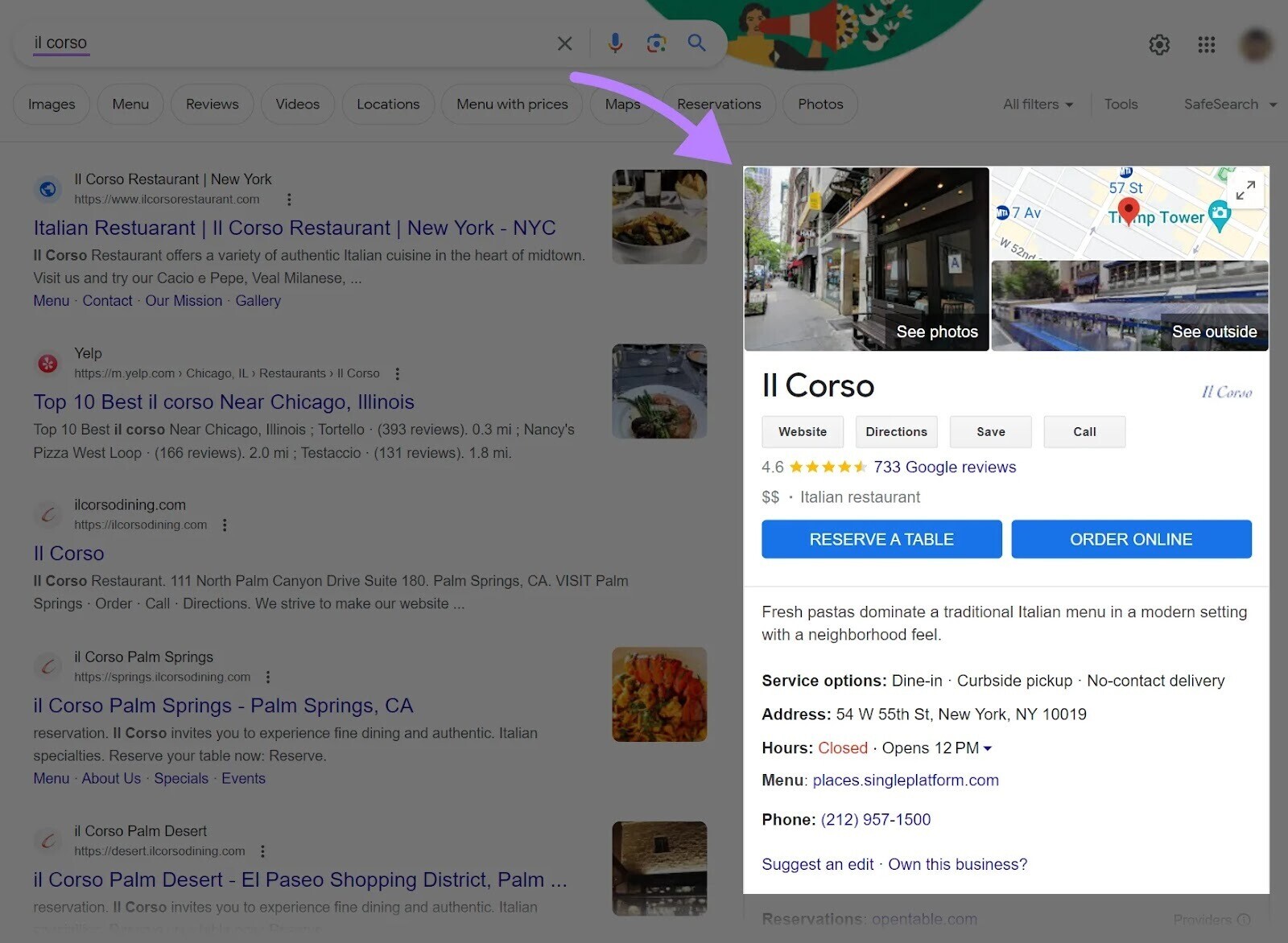
Companies with complete and optimized GBPs are more likely to appear in results that include phrases like “where to buy” and “near me.”
The search engine can pull this information from your profile to show to relevant searchers.
GBPs are essential for customer-facing businesses, whether or not they have physical storefronts.
Why?
Customers who find complete GBPs are 2.7x more likely to consider a business reputable. And trustworthy companies are more likely to get backlinks that further boost their authority.
To set up your GBP, visit Google Maps and open the menu (the three horizontal lines in the top left corner).

Find and click the “Add your business” button.
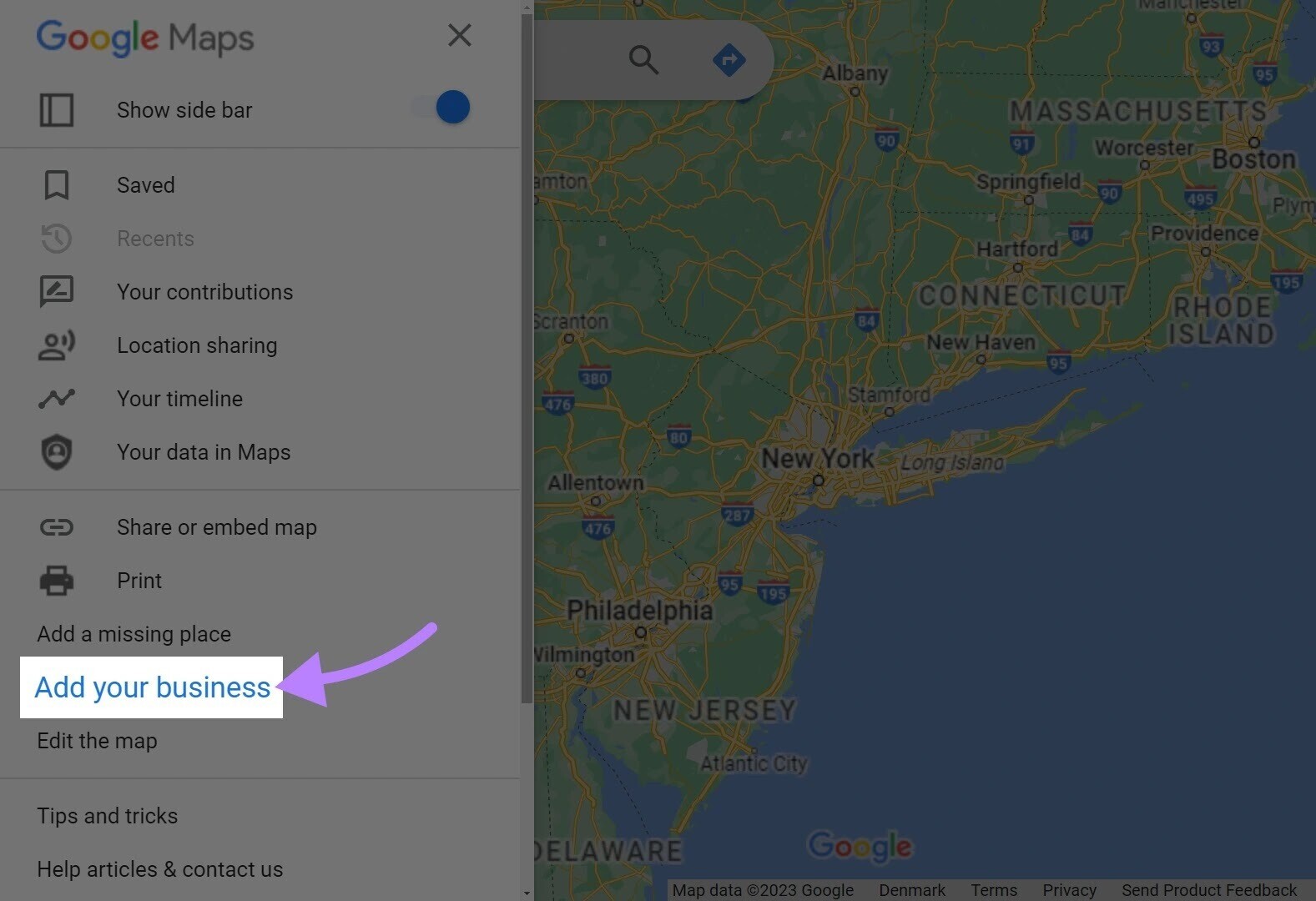
If you don’t have a business account, follow the steps in our guide to create one. (If you’re claiming an existing listing, there’s help for that, too.)
You can choose to add your company’s contact details to local directories manually.
On top of accurate NAP (name, address, phone number) data, Google recommends including helpful information about your products or services in your description.
Google doesn’t allow irrelevant content that’s:
- Low-quality or distracting (e.g., misspelled words or gibberish)
- Promotional or price-oriented (e.g., announcing special offers or sales)
- Any kind of link
Instead, use your GBP description to highlight what makes you different. Such as your company history and mission.
Alternatively, use Semrush’s Listing Management tool to manage your NAP information automatically across 70-plus directories in the U.S.
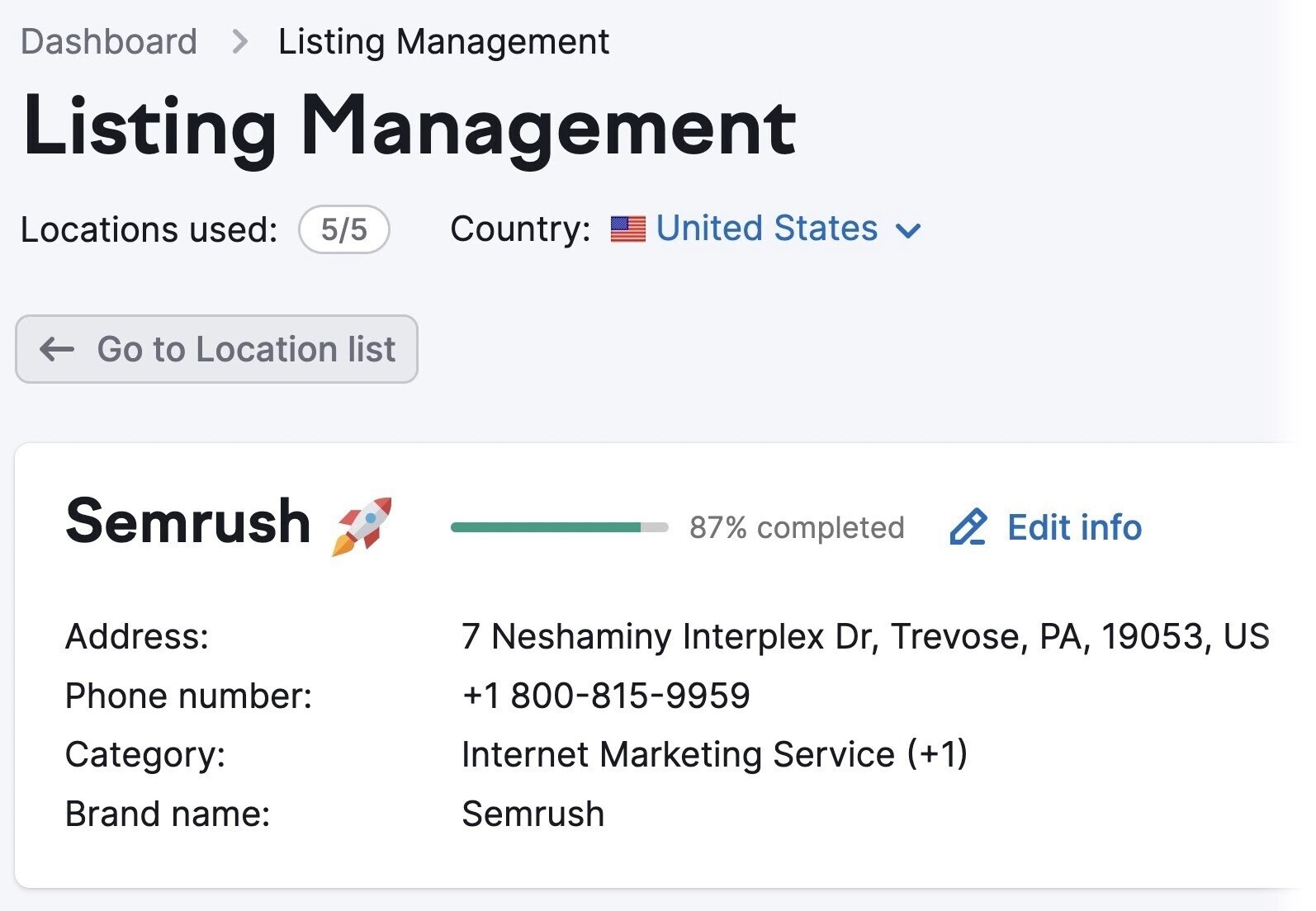
These optimizations will help you stand out and gain a competitive advantage.
4. PageSpeed Insights for User Experience
PageSpeed Insights is a free UX tool that analyzes the page speed of a website.
It attributes page scores of between 0 and 100 on both mobile and desktop devices.
Why is a fast site important?
Because a Portent study found that a site with a load time of 1 second has a three times higher conversion rate than one that takes 5 seconds.
Here’s what the PageSpeed Insights dashboard looks like:
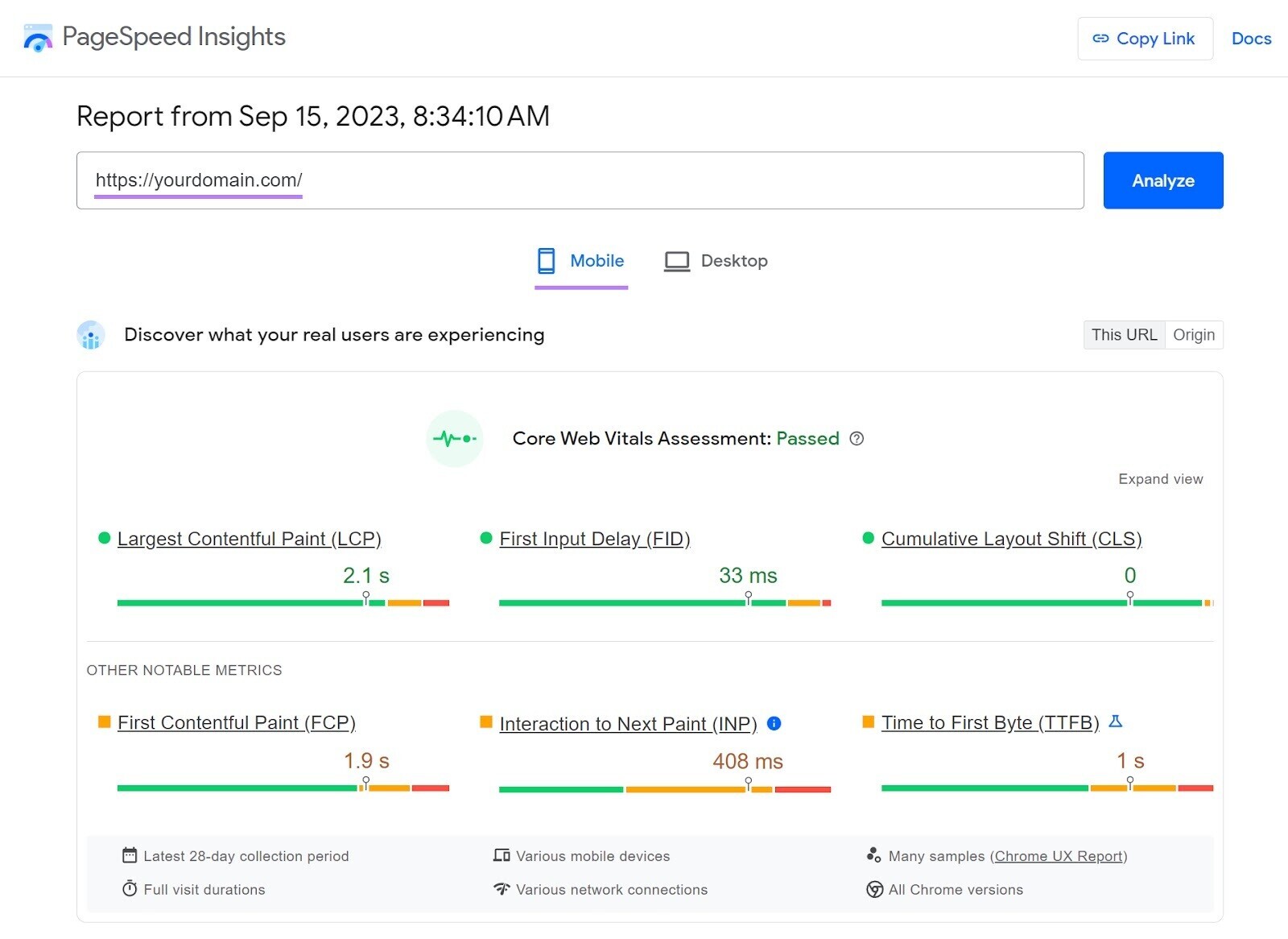
What Can PageSpeed Insights Do?
Google doesn’t use the tool to rank your site or content. But it does indicate factors that affect SEO. For example, page speed and page experience.
The higher your score, the faster and more efficient your site is. Which means it’s more likely to have a positive impact on your search rankings.
To see your score, go to Google’s PageSpeed Insights. Enter your URL and click “Analyze”:
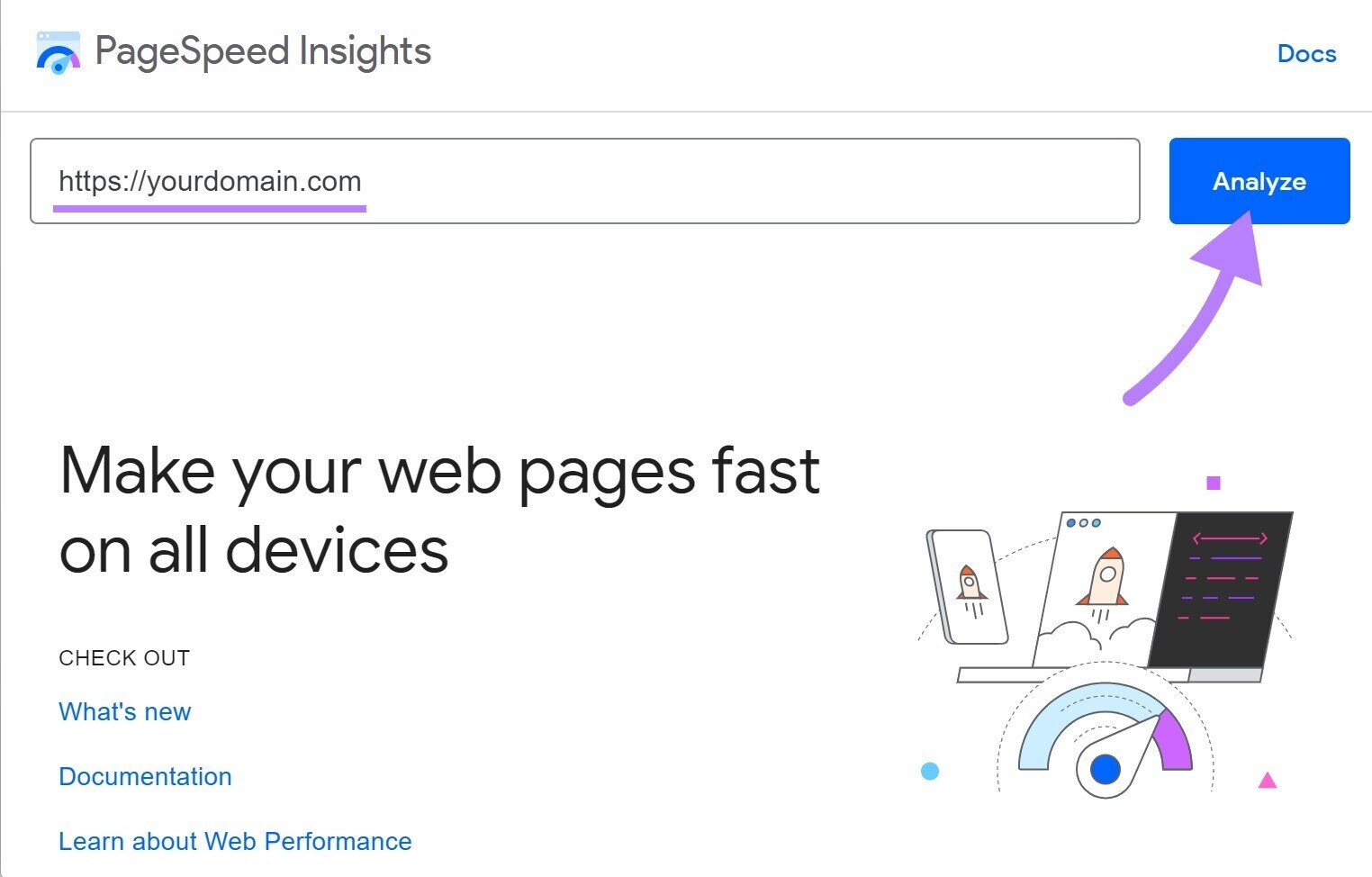
This may take a few seconds to a minute to complete. Depending on how much is on your page and how fast your internet is.
Once it’s finished, you’ll see a score for both mobile and desktop versions. Plus a list of opportunities to improve your page’s performance.
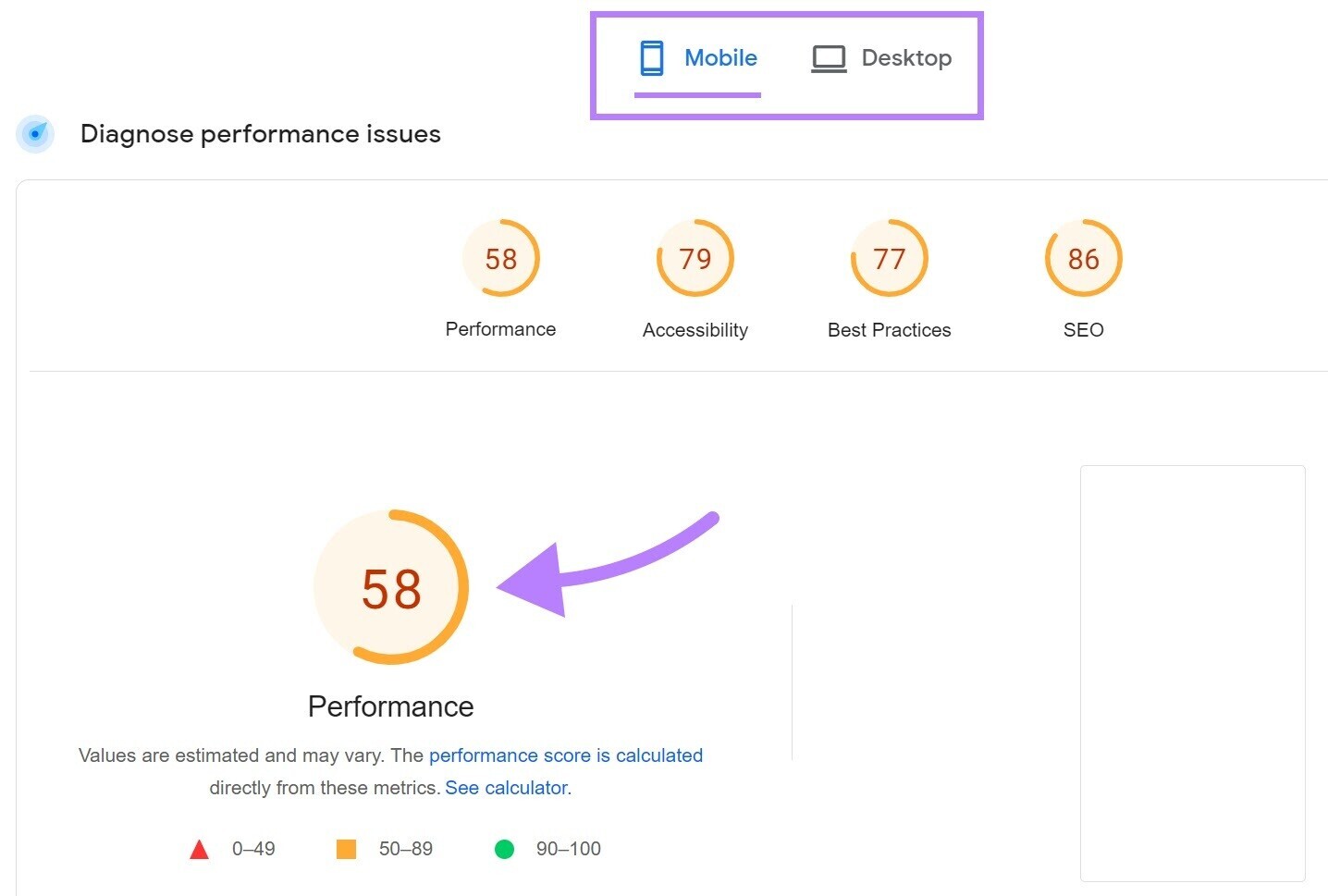
For each opportunity, you’ll see how much time you can save measured in seconds. This distinction helps you prioritize your fixes.
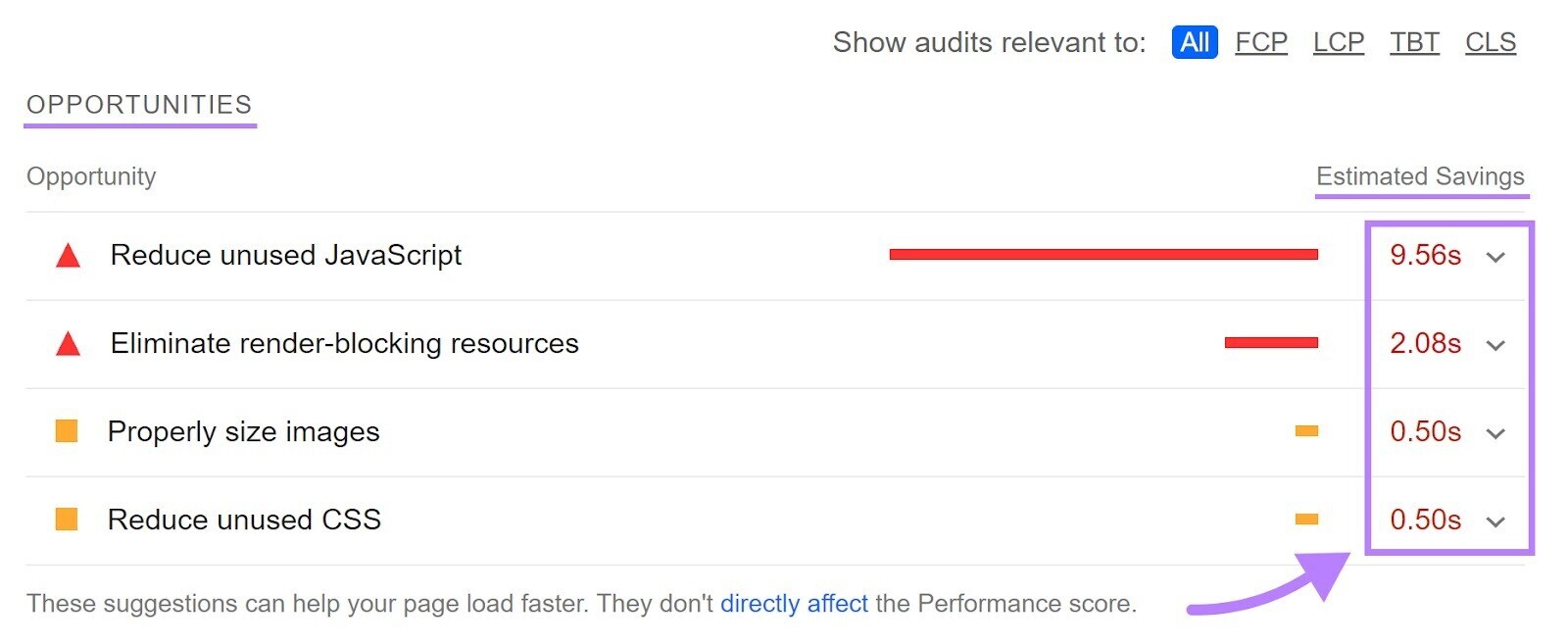
Covered everything? Re-run the analysis tool to see how much you’ve improved your page performance.
Further reading: Find out how to also use the free Google Lighthouse tool for SEO and performance audits.
For deeper page speed and SEO analysis of your whole site, use Semrush’s Site Audit tool.
It scans your site for more than 140 types of technical and SEO issues. Followed by a custom to-do list. So you know exactly what you need to fix and how.
Open the tool, enter your site’s domain, and click “Start Audit.”

You’ll need to configure Site Audit settings (either default or custom) on the next page. After that, click “Start Site Audit.”
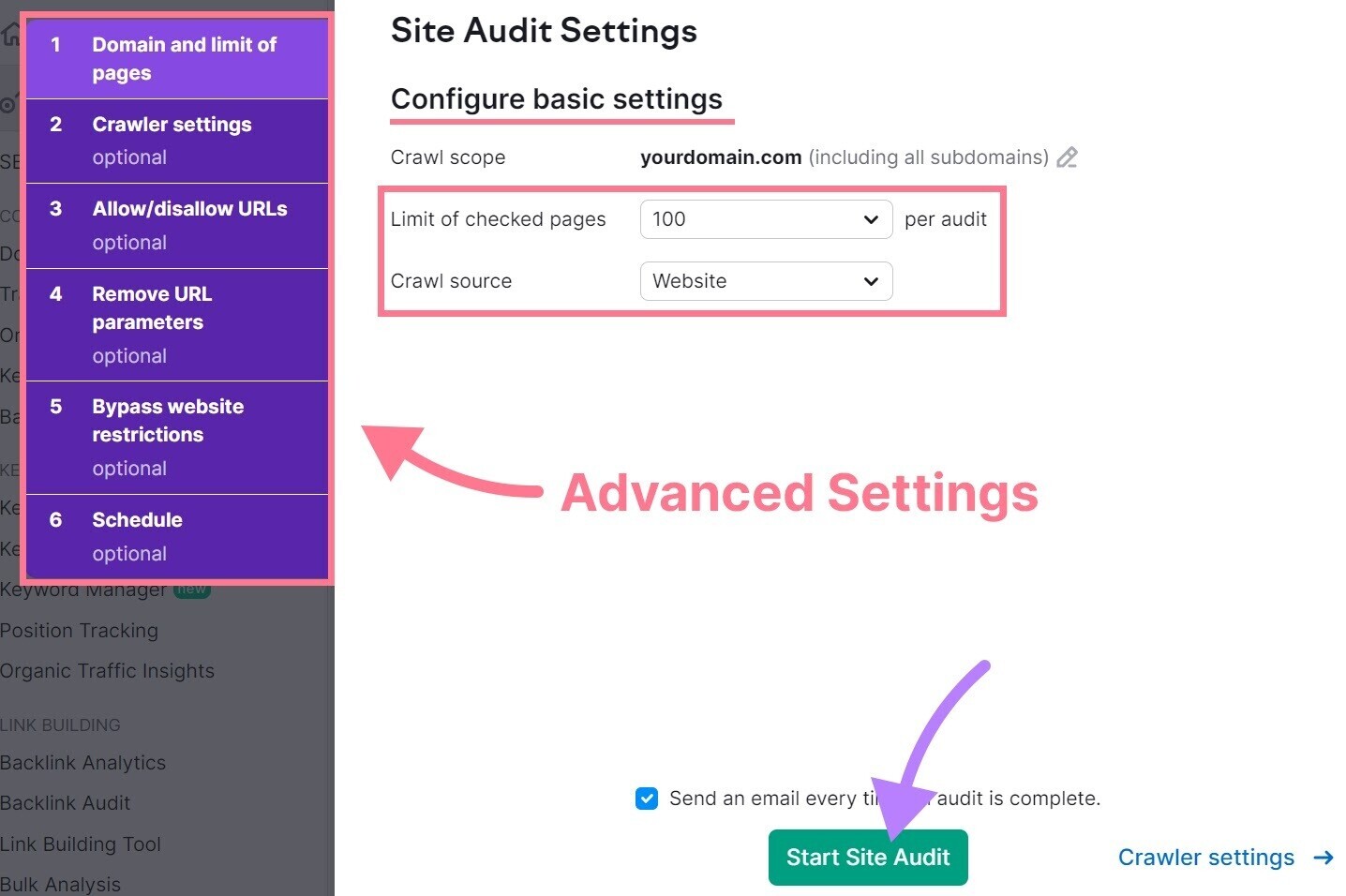
Find the section called “Site Performance” and click “View details.”
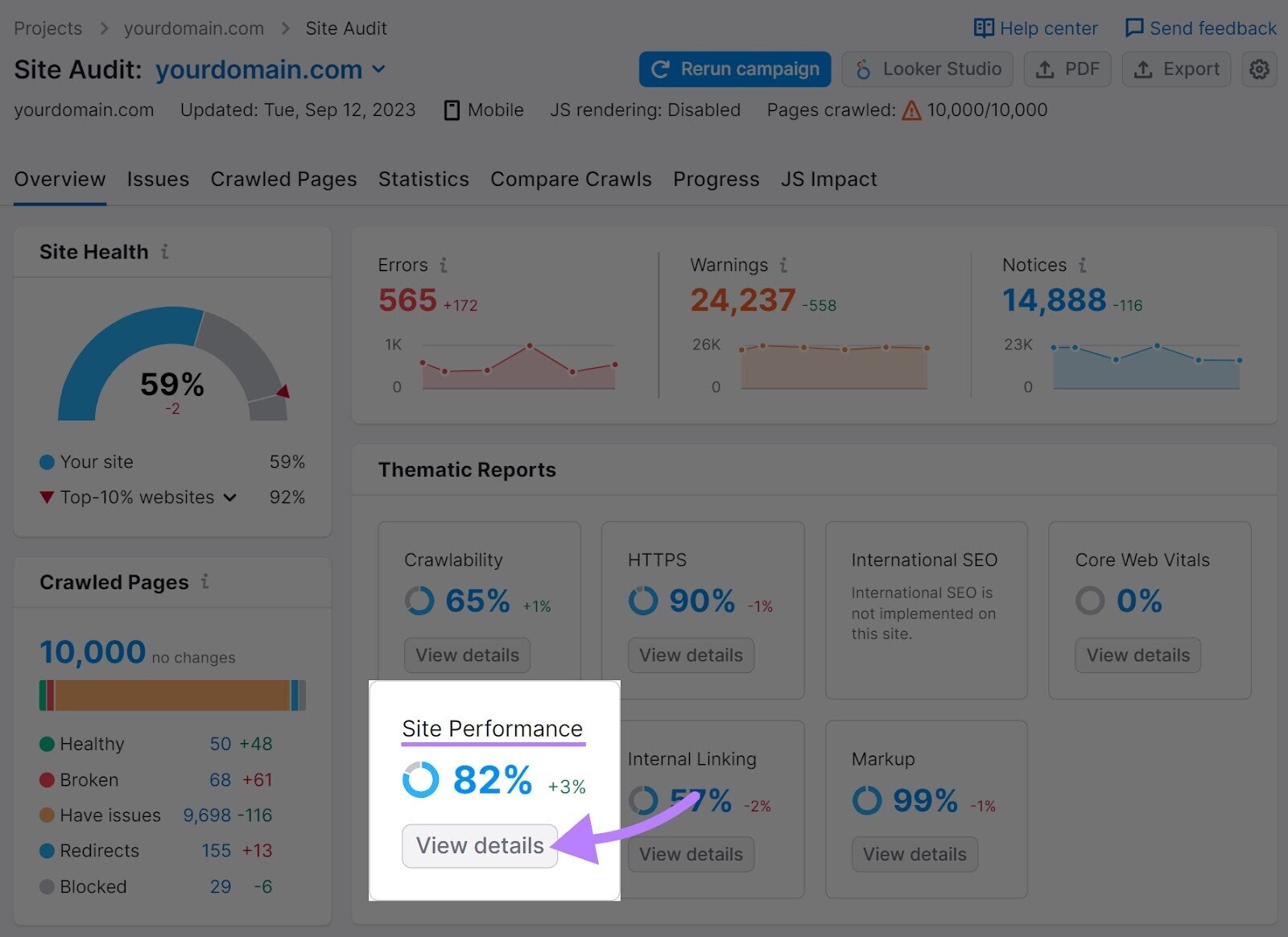
In the following report, you’ll see your average page load speed in seconds. Along with a list of issues impacting your site’s performance on the right.
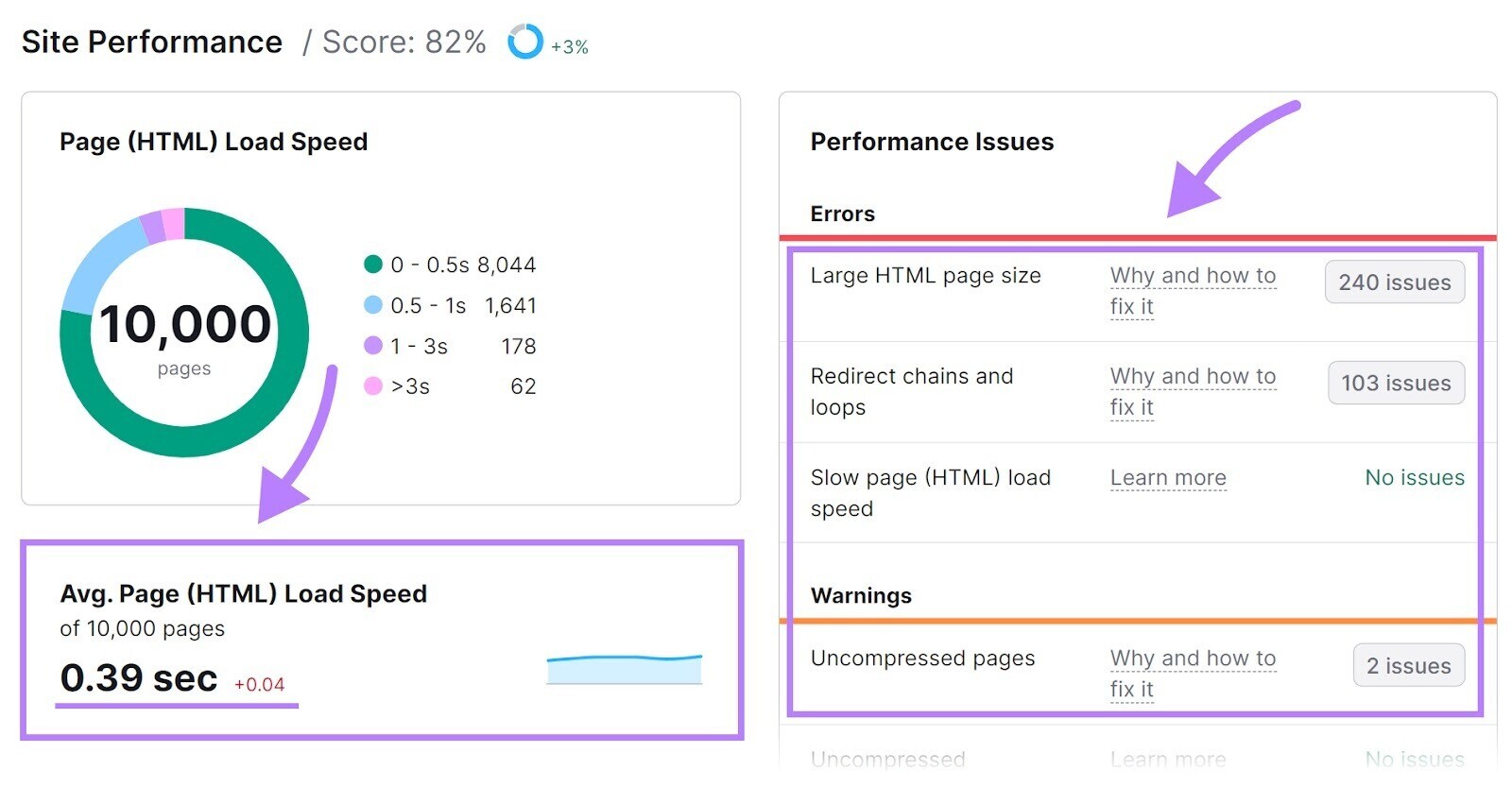
Issues can include:
- Large HTML pages
- Redirect chains and loops
- Slow loading speeds
- Uncompressed pages
Semrush’s Site Audit helps you identify and fix these errors to keep your site running smoothly.
Simply click “Why and how to fix it” next to each item to learn how to remedy the problem.
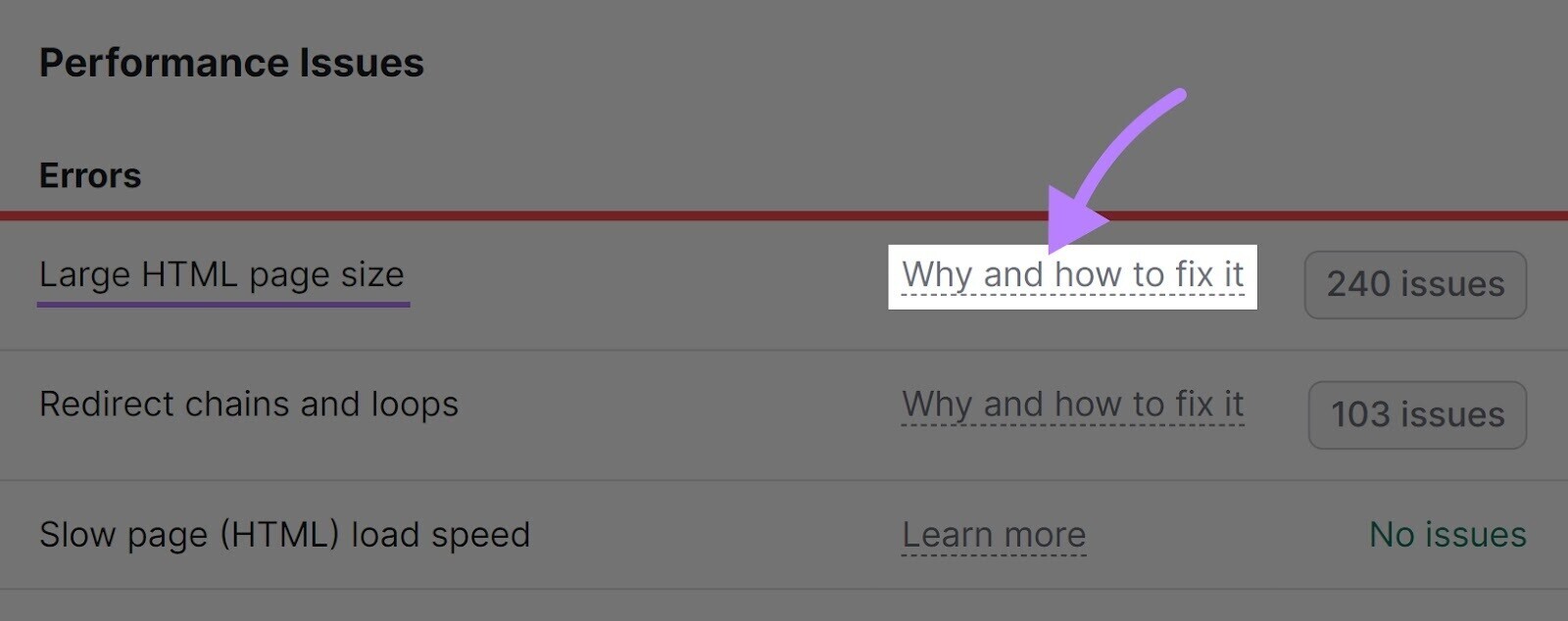
For example, an issue with page load speed brings up the following:
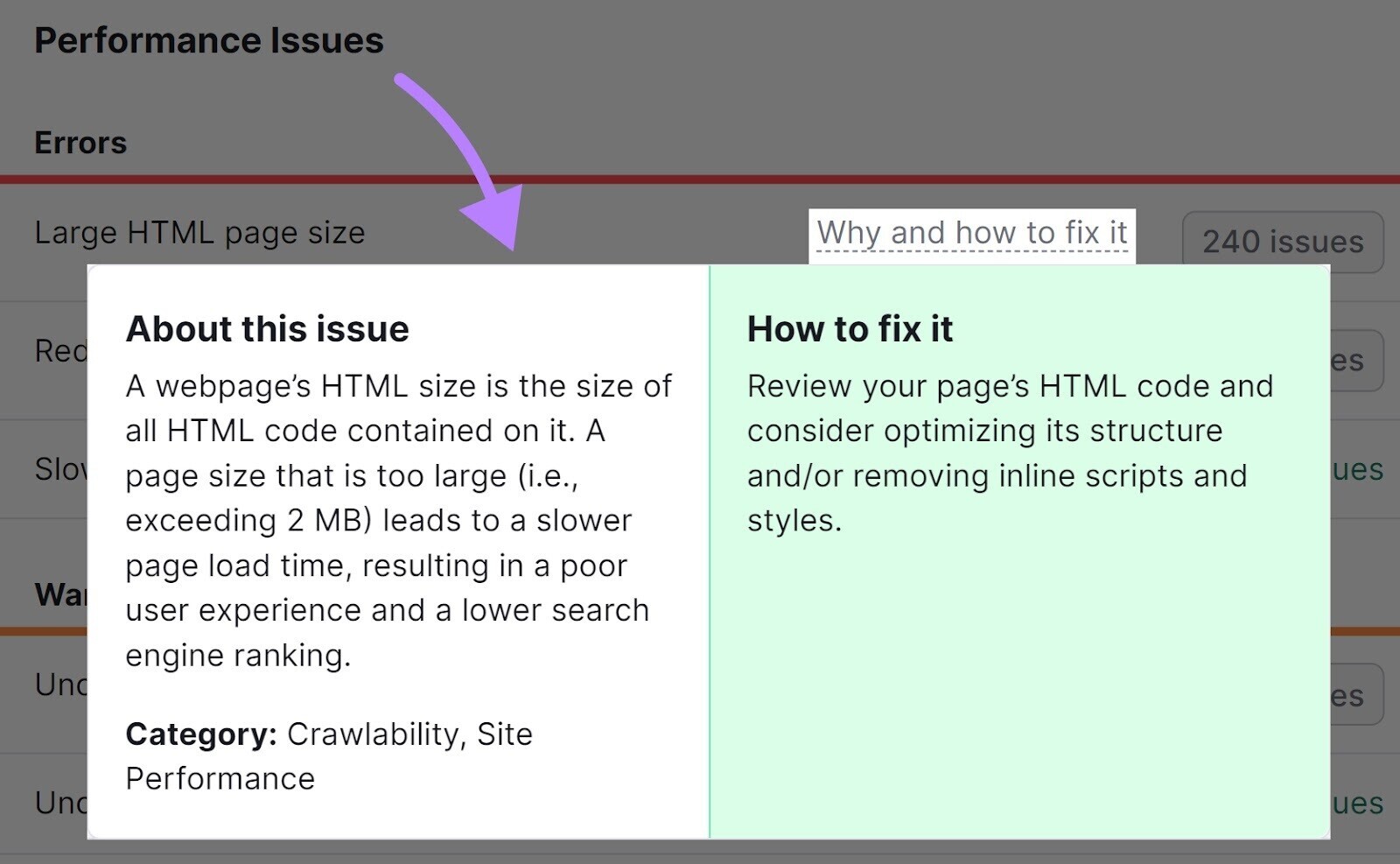
Run these audits regularly to ensure your site stays speedy and performs optimally.
5. Google Trends for Topic Research
Google Trends is a free tool that uses real-time data to analyze the popularity of Google search terms.
See how time, season, and location impact each topic. Then, use these insights to inform the content you write about.
How Does Google Trends Work?
You can check Google Trends to:
- Identify seasonal trends (e.g., “flowers for Valentine’s Day”)
- Monitor your competitors (e.g., compare “Netflix” to “Hulu”)
- Optimize your local SEO strategy (a trending topic about surfboards will be more attractive to coastal states)
Because they’re popular topics, more people than usual will want to read about them.
For example, soccer’s Inter Miami started trending thanks to Lionel Messi joining the team.
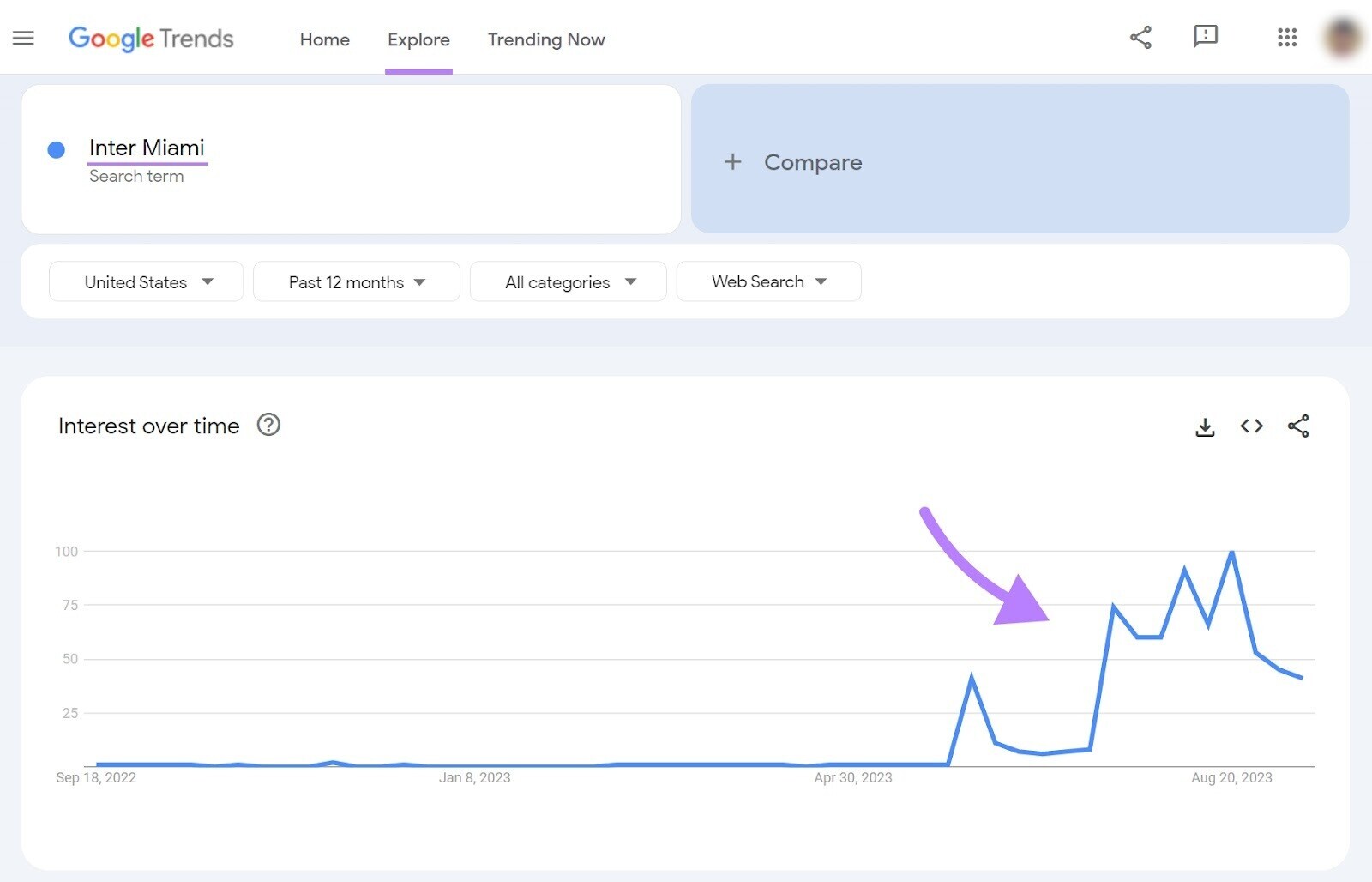
If you had a sports blog, you could jump onto the trend and write about Messi’s journey.
Type in a search term on the Google Trends page to find relevant topics. Or click on one of the suggested options under the “Trending Now” tab.
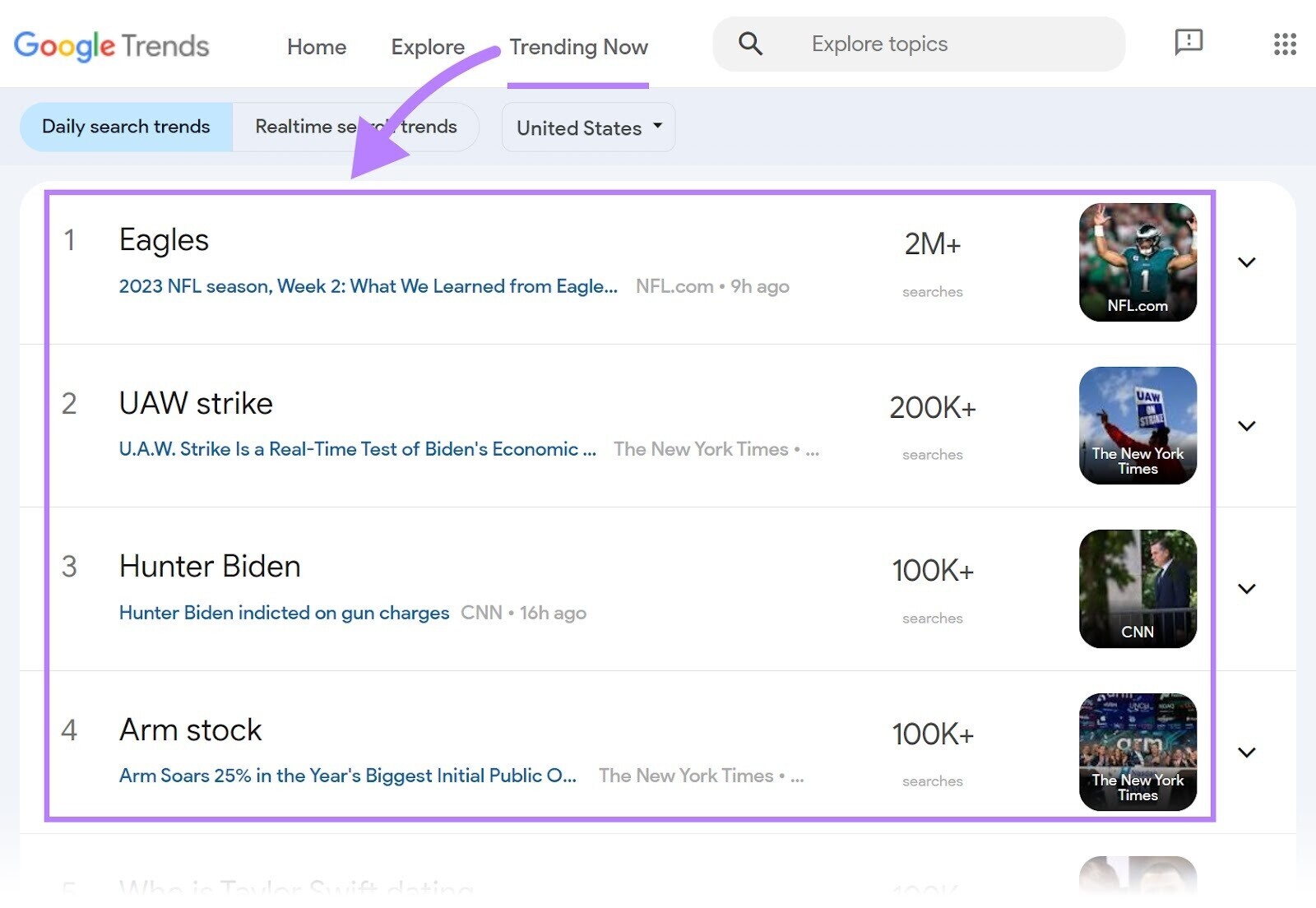
You can also use Google Suggest to focus your ideas further.
Google Suggest is the predictive text that comes up when you type a query into Google’s search box. You’ve probably used this free tool without even realizing it.
Let’s say you type “Inter Miami.” Here are Google’s suggestions:
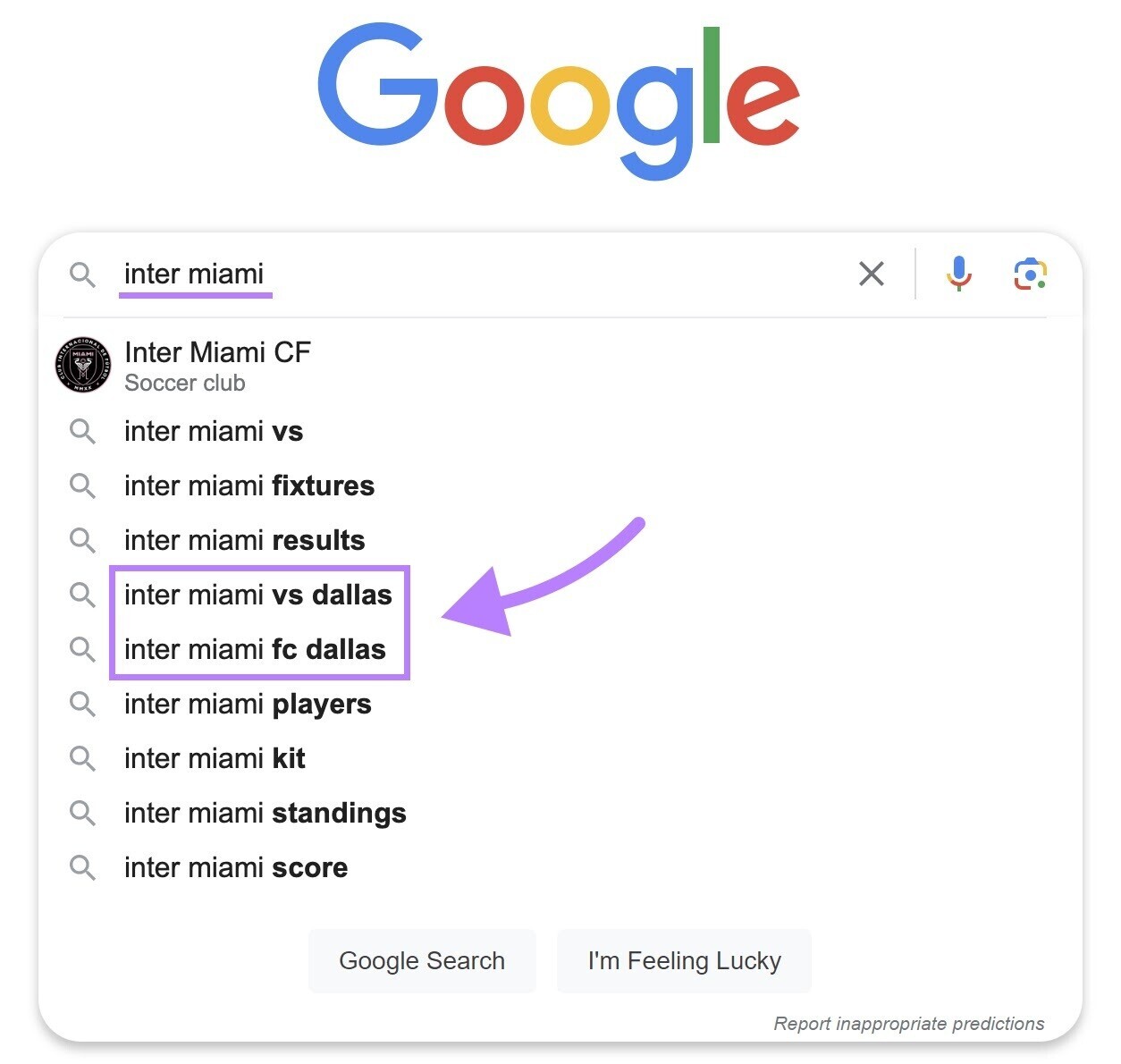
The above may inspire you to write about the recent game between Inter Miami and FC Dallas. Or about the team’s current players.
Timely articles increase your chances of driving valuable traffic to your site.
Want to dig deeper into trending topics and more content ideas? Try Semrush’s Topic Research tool.
Type an idea in the search bar.
Here’s one: “ food without chicken.”
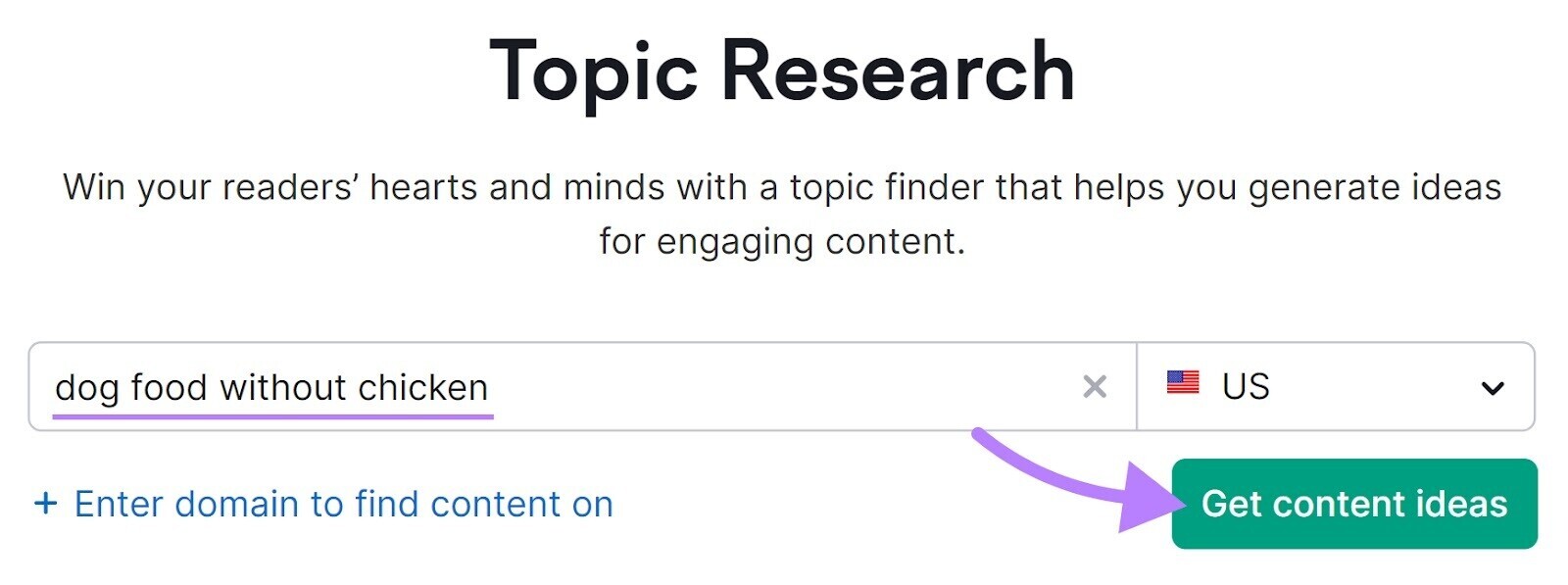
Specify your location to target your search further. Click “Get content ideas.”
In the “Overview” tab, you’ll see:
- Headlines: The most backlinked page titles for the topic in question
- Questions: The most frequently asked questions about the topic
- Related Searches: The search terms queried alongside the topic
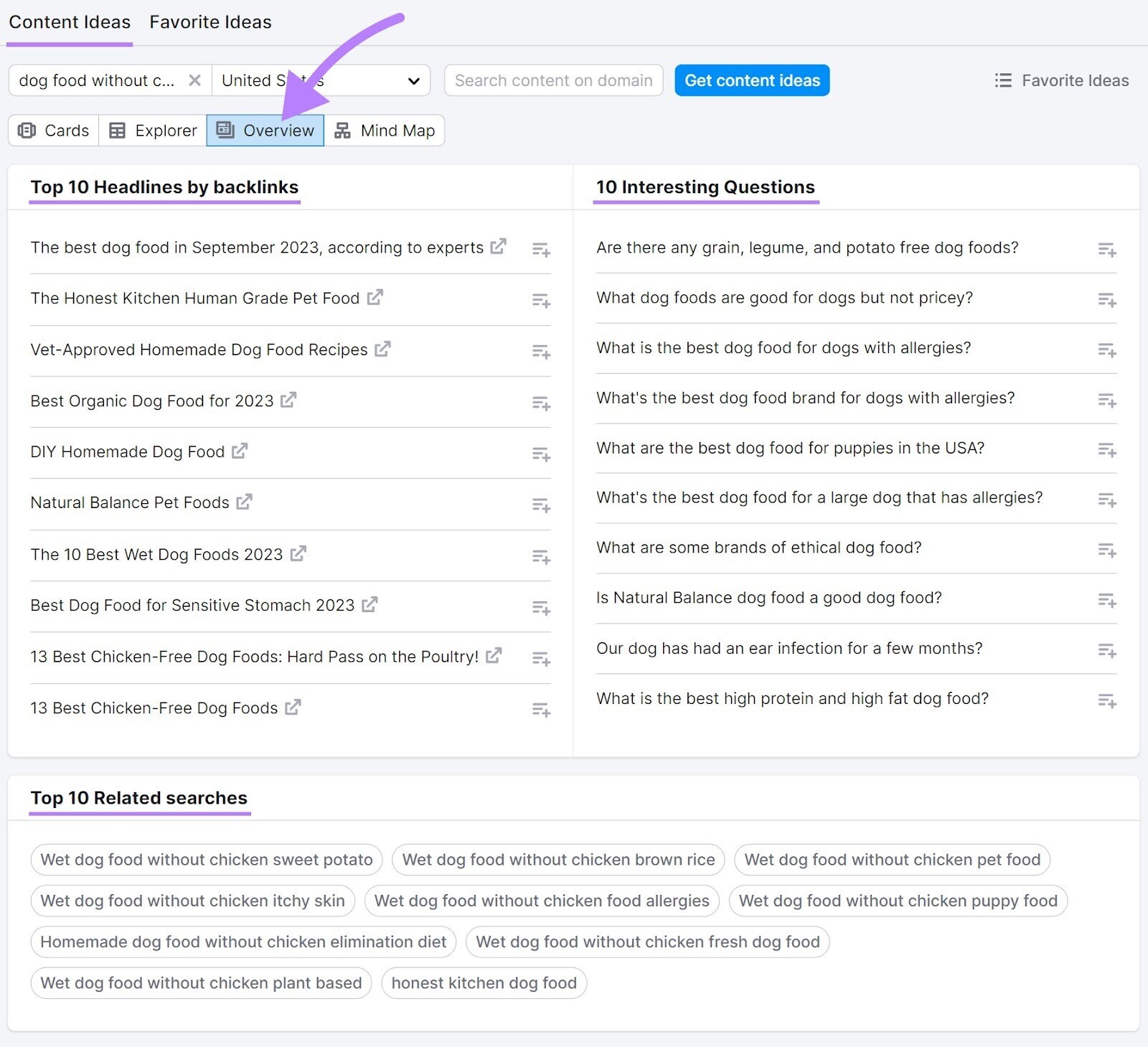
Use the ideas to inspire you. Or create engaging content that answers questions about topics people are already discussing.
Further reading: Harness the power of Google Trends guided by five use cases.
6. Google Keyword Planner for Keyword Research
Google Keyword Planner is a free keyword research tool. It’s technically for pay-per-click (PPC) advertising. But you can also use it to uncover keyword ideas for organic search.
Here’s how it works:
- Identify new keywords
- Compare their estimated search volumes
- Learn how much they’d cost to bid on. In other words: their cost per click (CPC)
That allows you to consider relevant options and prioritize those most likely to bring you results.
First, set up a Google Ads account to access Google Keyword Planner.
Click “Start now” on the Ads homepage.
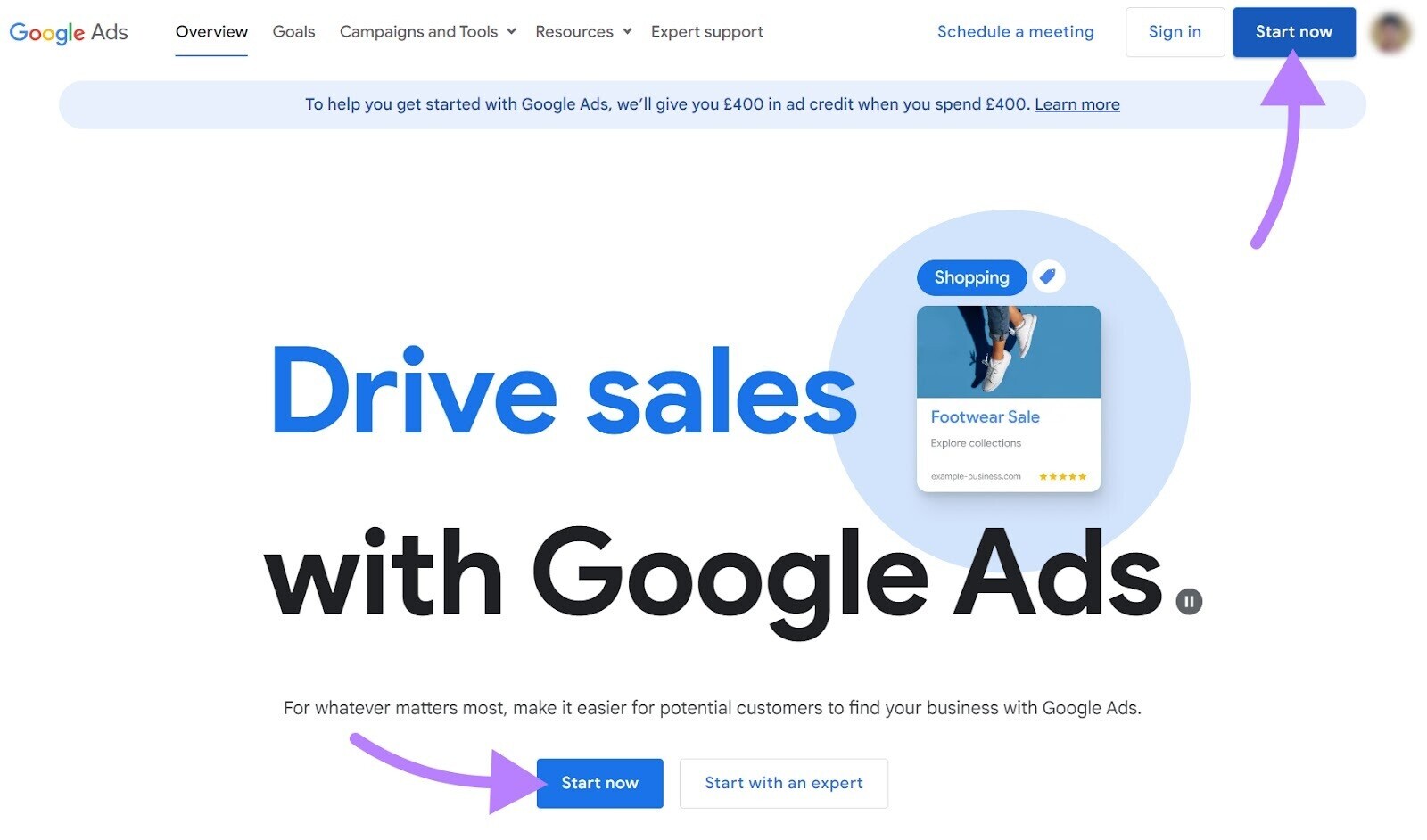
Follow the easy steps in our guide to complete the setup.
The keyword research process helps you understand your niche and target audience better. Using relevant search terms in your content means you’re more likely to attract qualified traffic to your site.
Without keyword research, you might target search terms no one is using. Limiting your organic traffic as a result.
What Can You Do With Google Keyword Planner?
You have two options when using the tool:
- “Discover new keywords” to find ideas for specific keywords
- “Get search volume and forecasts” to look at existing keywords and analyze search volumes, historical metrics, and forecasts

There are several routes you can take from here. Some relate to keywords you suggest (e.g., “Inter Miami” in the soccer example above). Others relate to a particular website you input.
Say you want relevant keywords for running shoes.
Enter “running shoes” into the search bar. You’ll get a list of brand-related keywords.
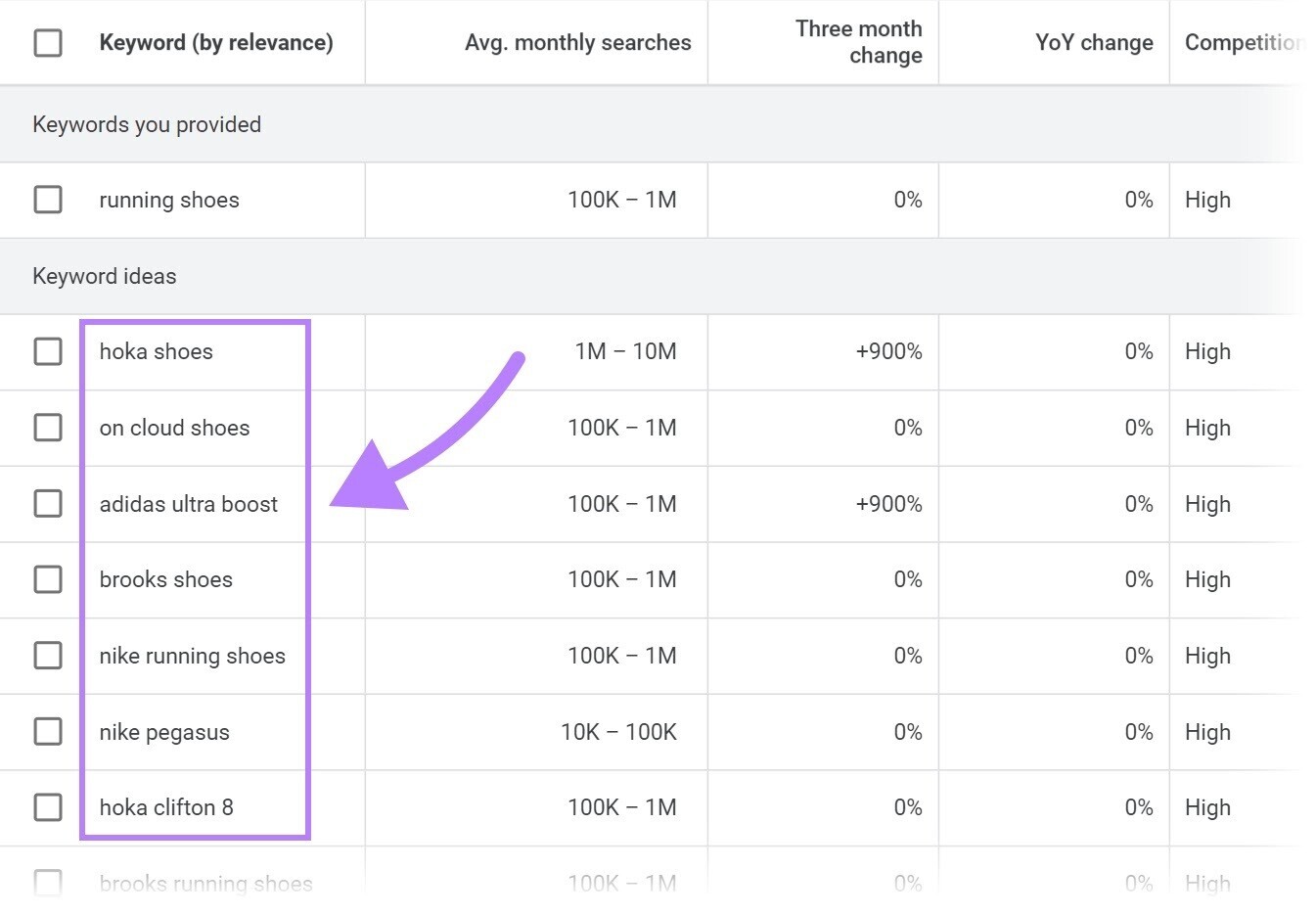
Not all of these will be relevant to your business. Use the “Refine keywords” column on the right to filter your list.
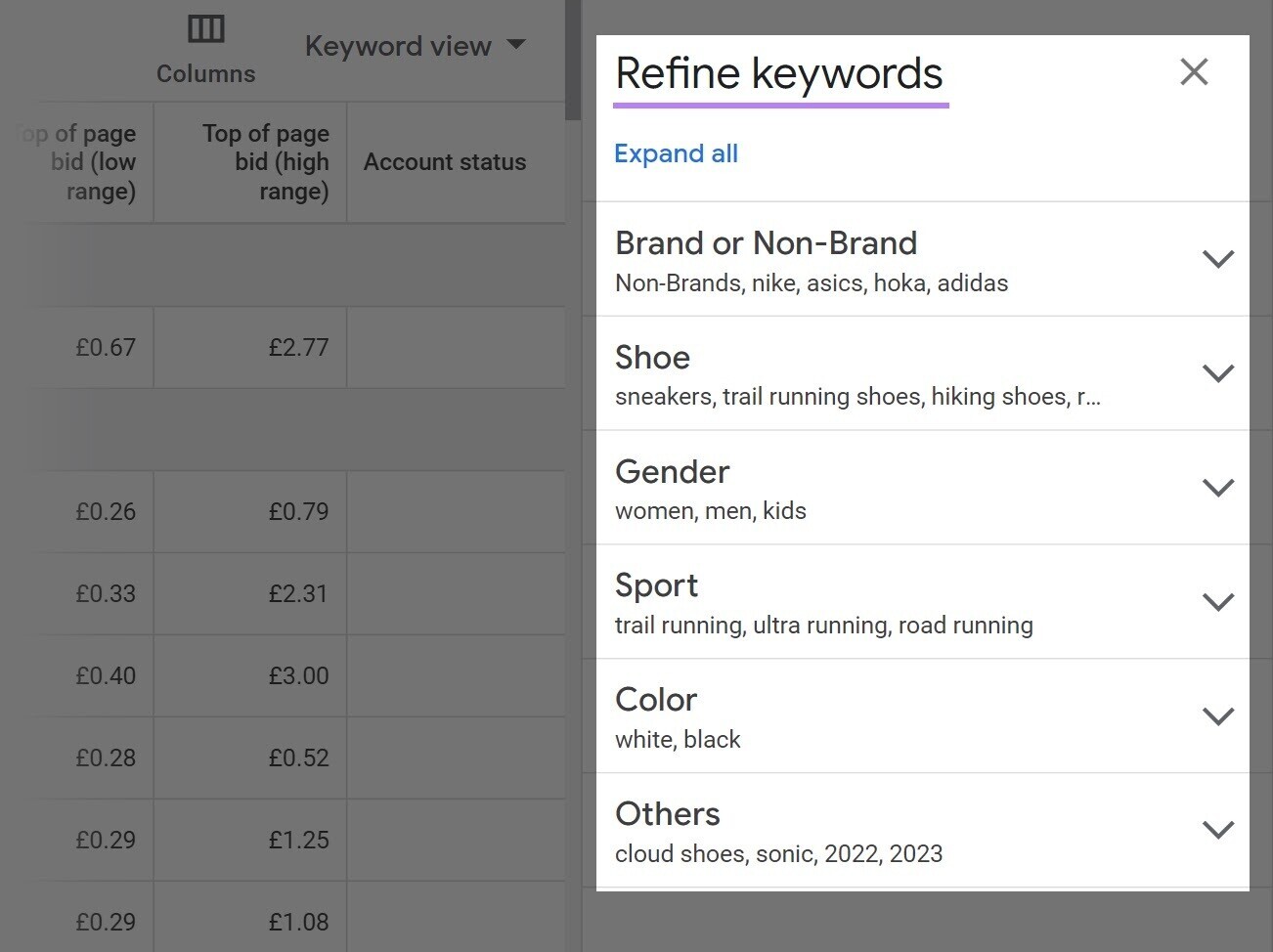
This narrows down your suggested keywords by attributes such as brand, type of shoe, and sport.
Ready to take your research further? Use Semrush’s Keyword Magic Tool for a deeper SEO-based process.
Pro tip: Create a free Semrush account and get 10 free daily searches.
Open Keyword Magic Tool and enter a phrase that relates to your business. We’ll use “surfboards” for this example.
Click “Search.”

A list of related keywords will be displayed.
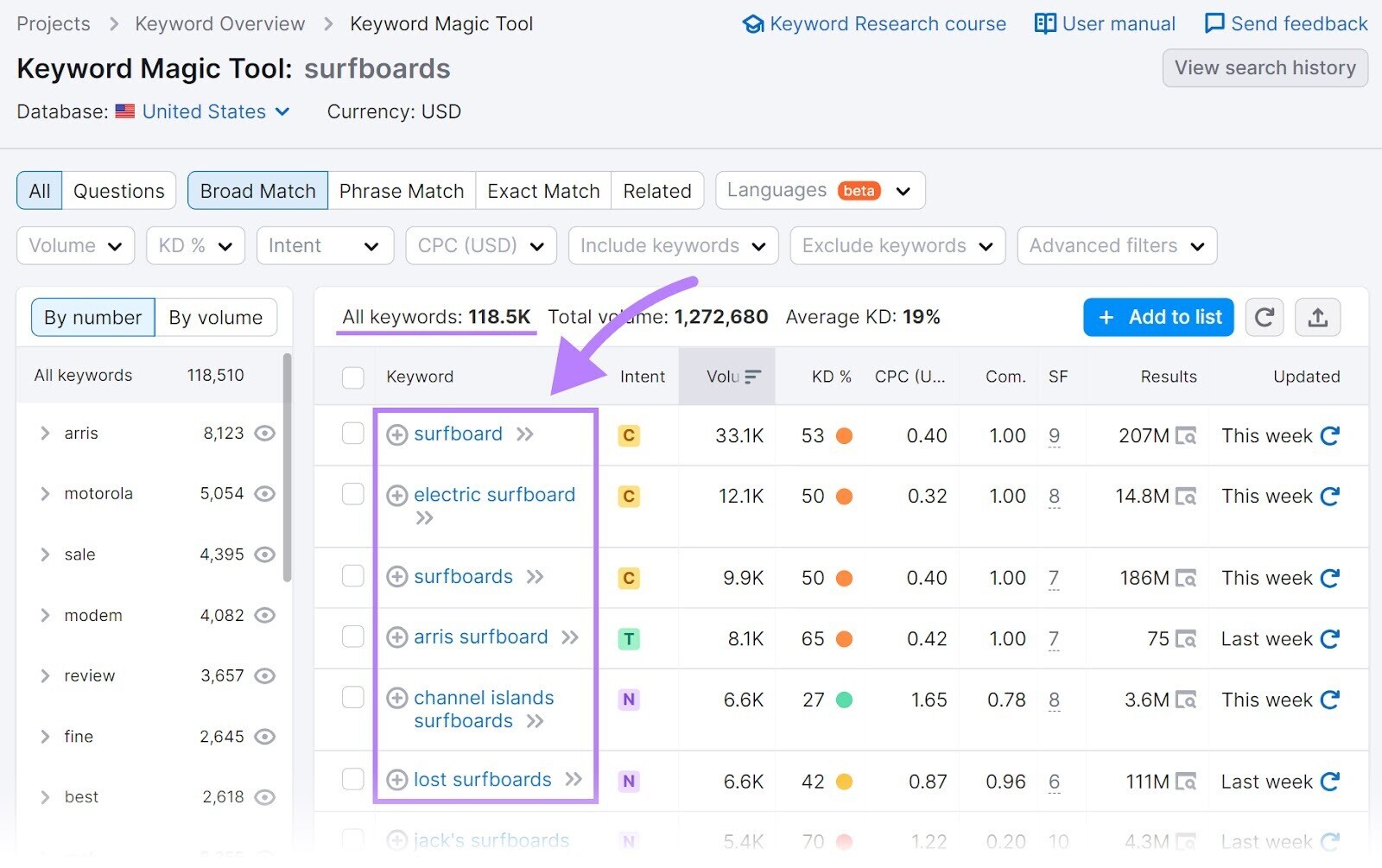
Use the column on the left to narrow your results by topic.
Click the eye icon next to an irrelevant result to hide it. Here, we’ll eliminate “Arris” and “Motorola”—“surfboards” in these cases refers to modem/router combos.
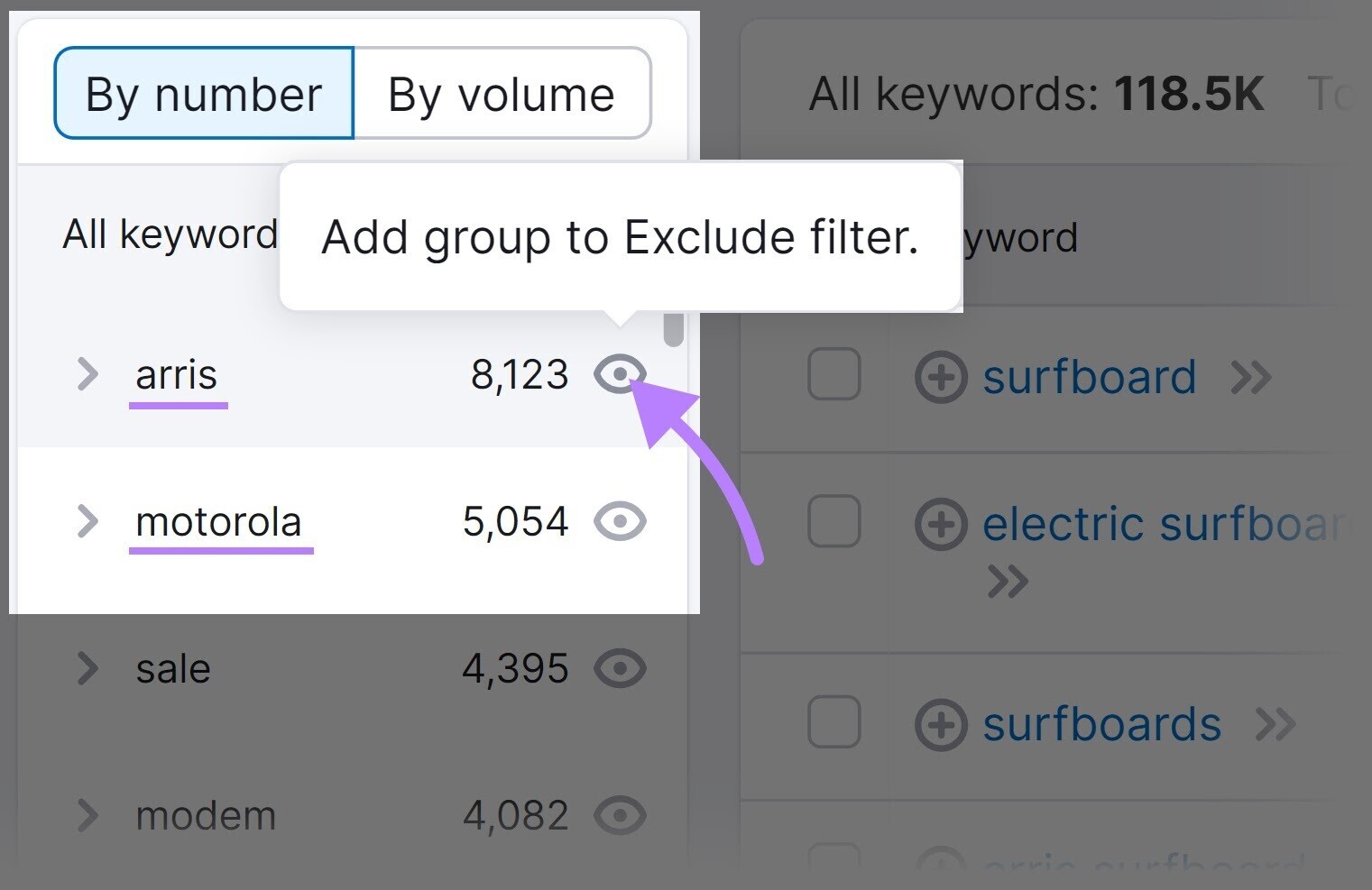
Clicking “review” will display the results that include the term.
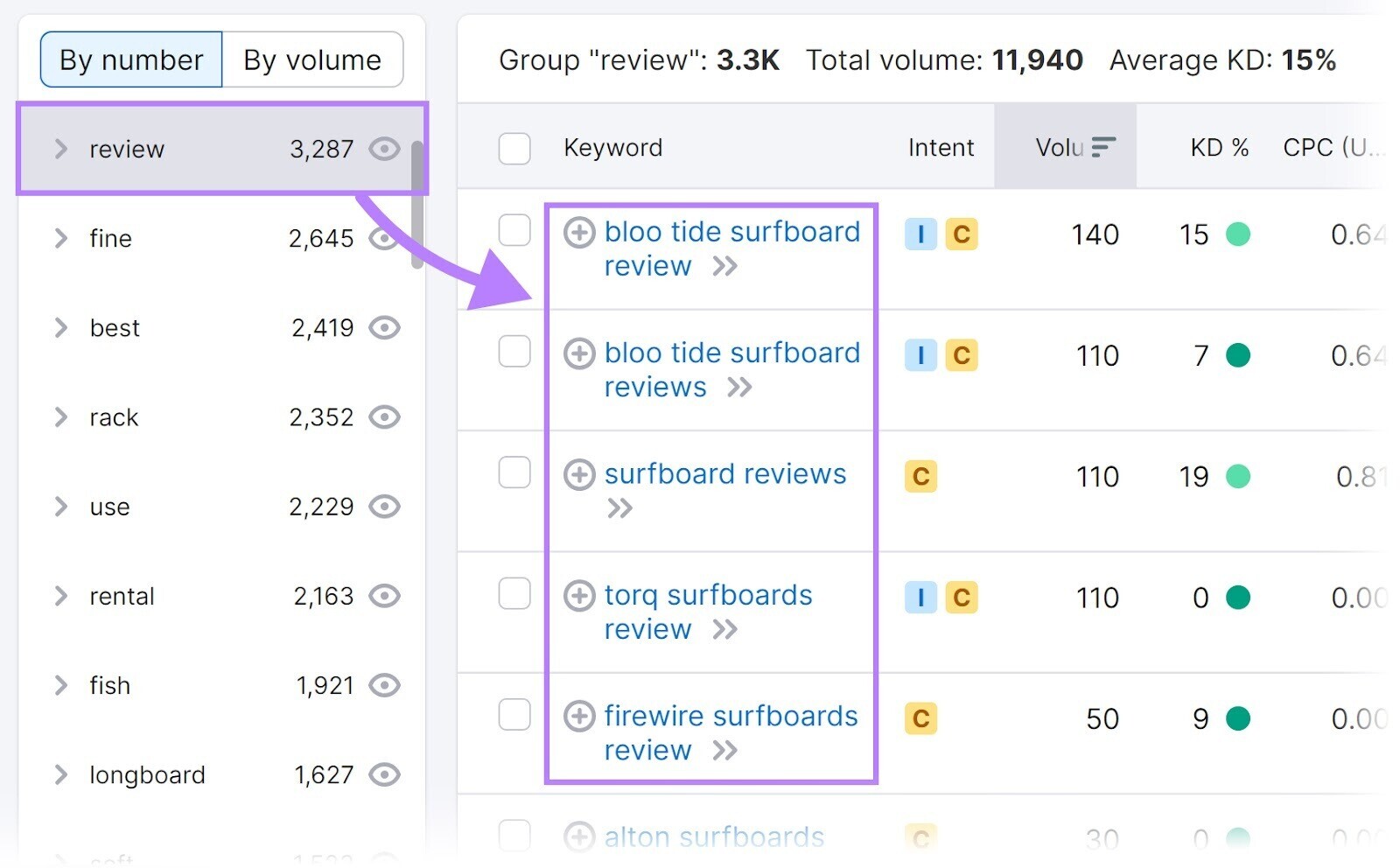
The “KD” column indicates keyword difficulty. The lower the number, the easier the keywords will be to rank for.
Highly specific search queries with low search volumes such as these review-related ones are known as long-tail keywords.
Keyword Magic Tool lets you click to filter them from easiest to hardest.
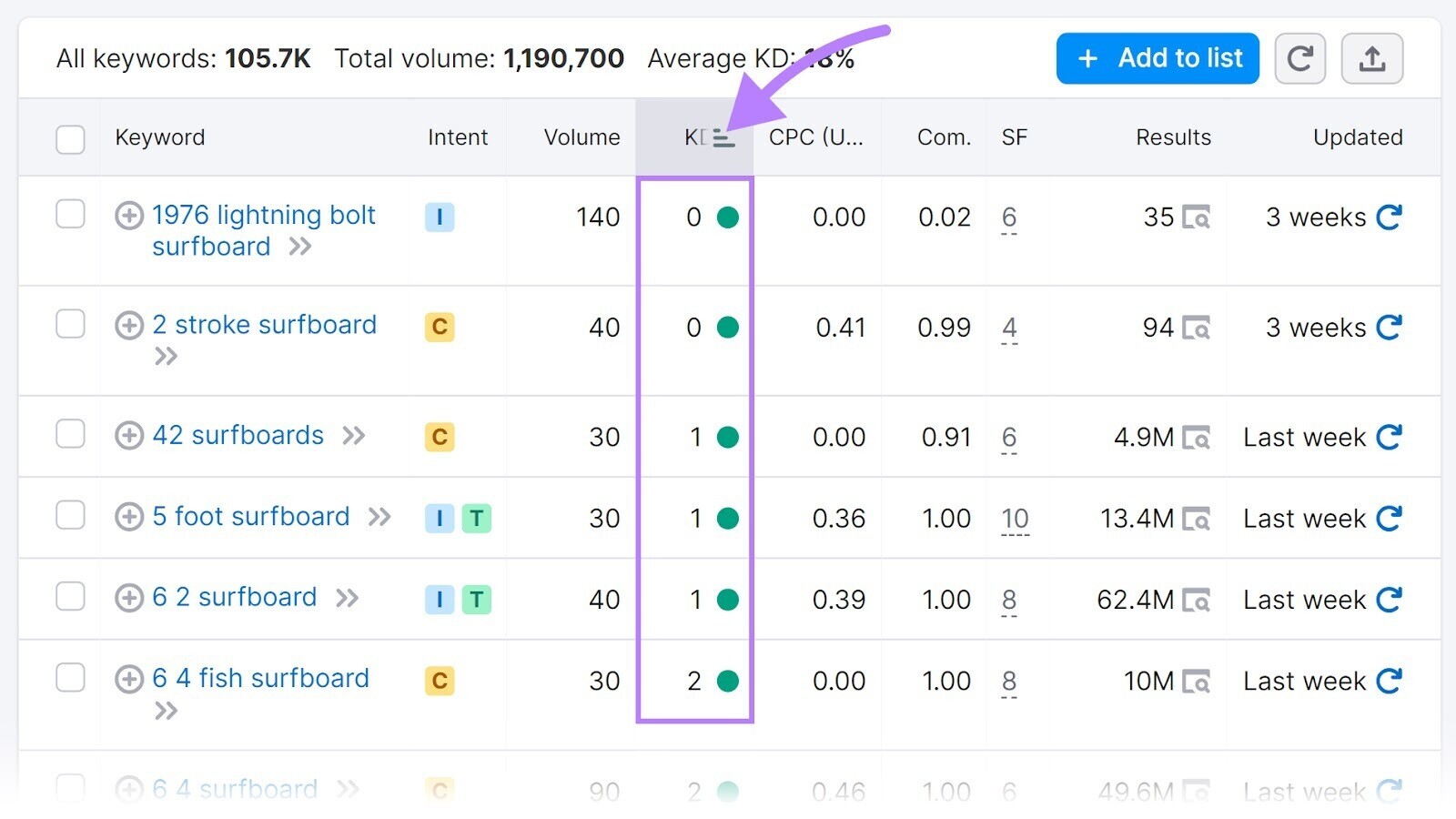
You could write a review of the brands of surfboards you sell. Or create a video comparing two or three of them.
This strategy can pull in new potential customers over time. And get your brand name out there as an authority in your niche.
Pro tip: Use Google Alerts to monitor the web for specific keywords and get inspired by new content built around your topics.
7. Mobile-Friendly Test for Mobile Usability
Mobile-Friendly Test is a free Google SEO tool that lets you check the mobile usability of individual pages on your site.
More than 70% of shoppers use their phones to buy online. Your site must cater to this growing segment of internet users.
If users struggle to access it on their mobile devices, they may leave. If this happens too often, your bounce rate increases. And rankings decrease.
On top of that, Google’s algorithm indexes and ranks content using your site’s mobile version. It’s known as mobile-first indexing.
Providing a solid mobile UX means searchers are more likely to revisit your site, read your content marketing, sign up, and spend money.
What Can Mobile-Friendly Test Do?
You don’t need to log in to use Google’s Mobile-Friendly Test. Simply paste a URL from your site onto the page and click “Test URL.”
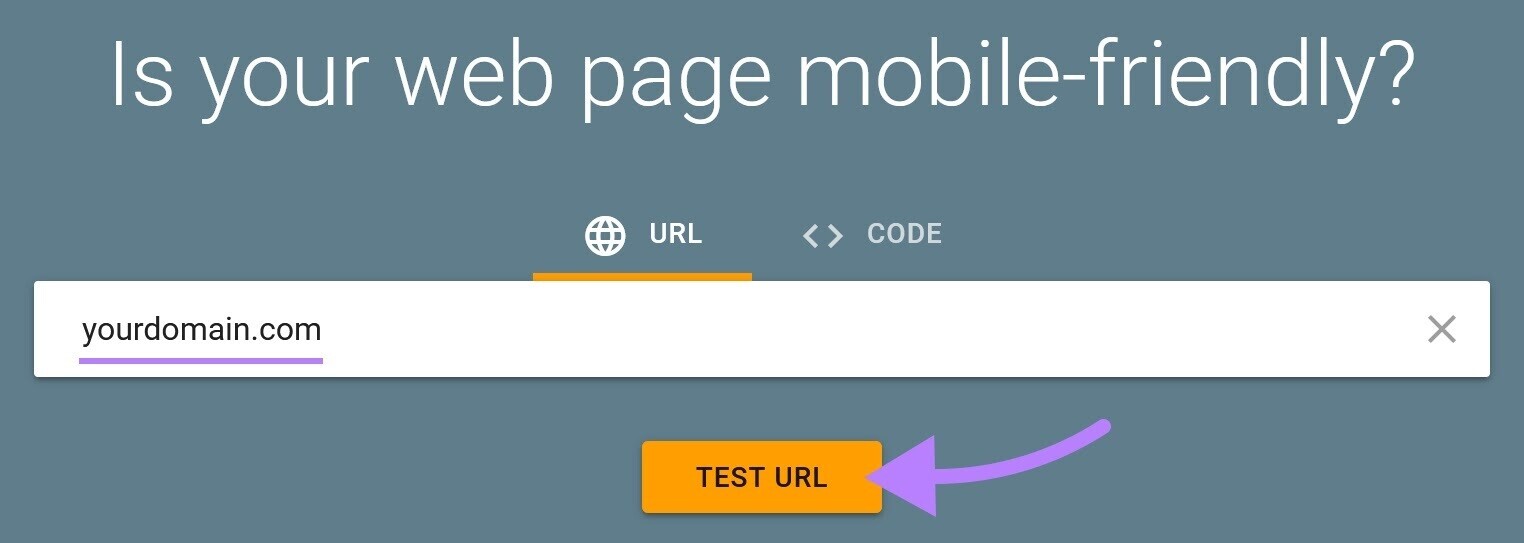
The tool will let you know if the page is mobile-friendly.

A negative result reveals what you must fix to optimize your page for mobile devices.
Hover over an issue and click the question mark that appears.

Semrush’s Site Audit tool provides a more comprehensive look at your site’s mobile-friendliness.
When setting up your audit, check that you’ve set your crawler settings to “SiteAuditBot-Mobile.”
Click “Start Site Audit” next.
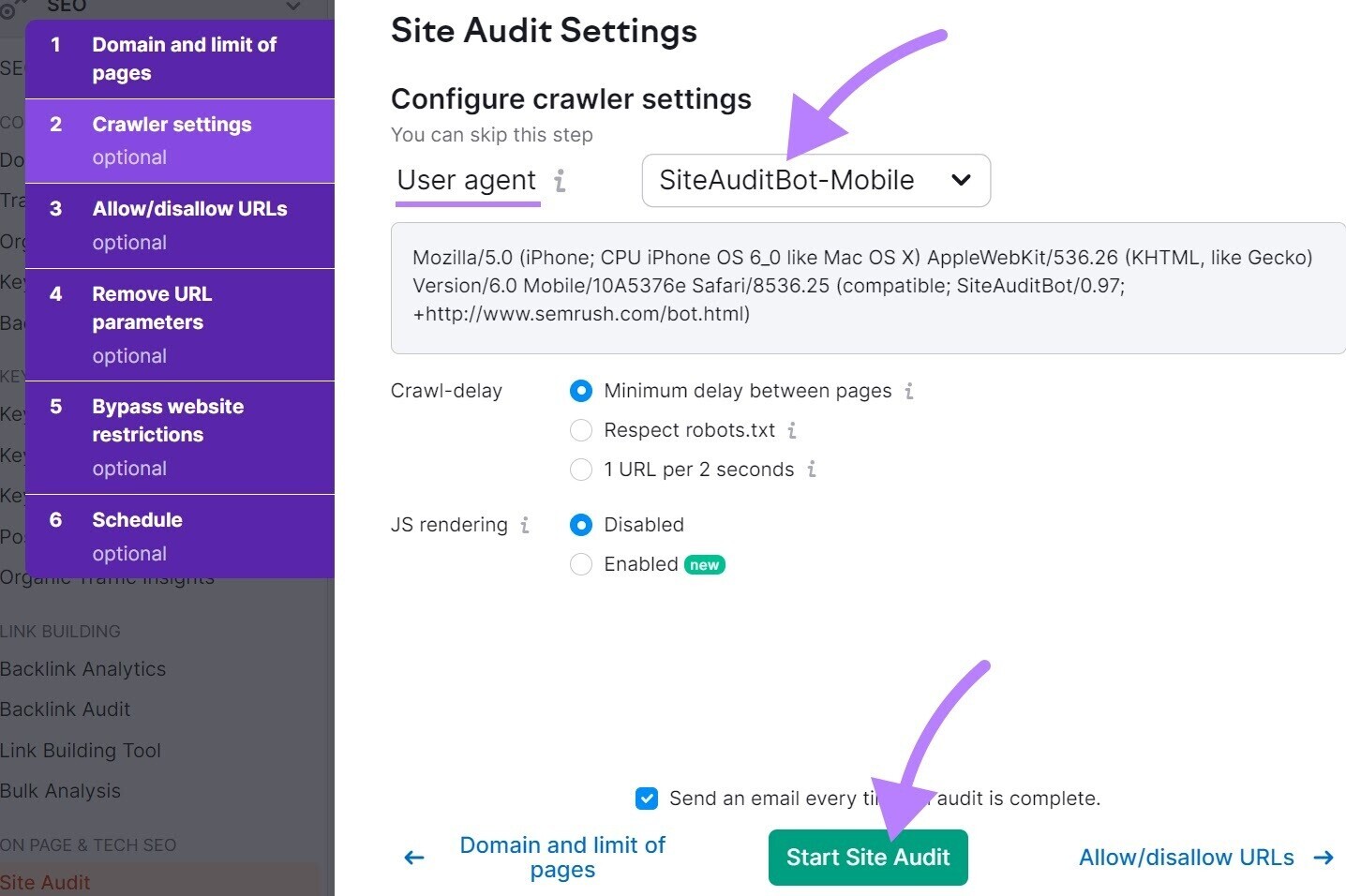
Look for the “Core Web Vitals” report on your main dashboard. Click “View details.”
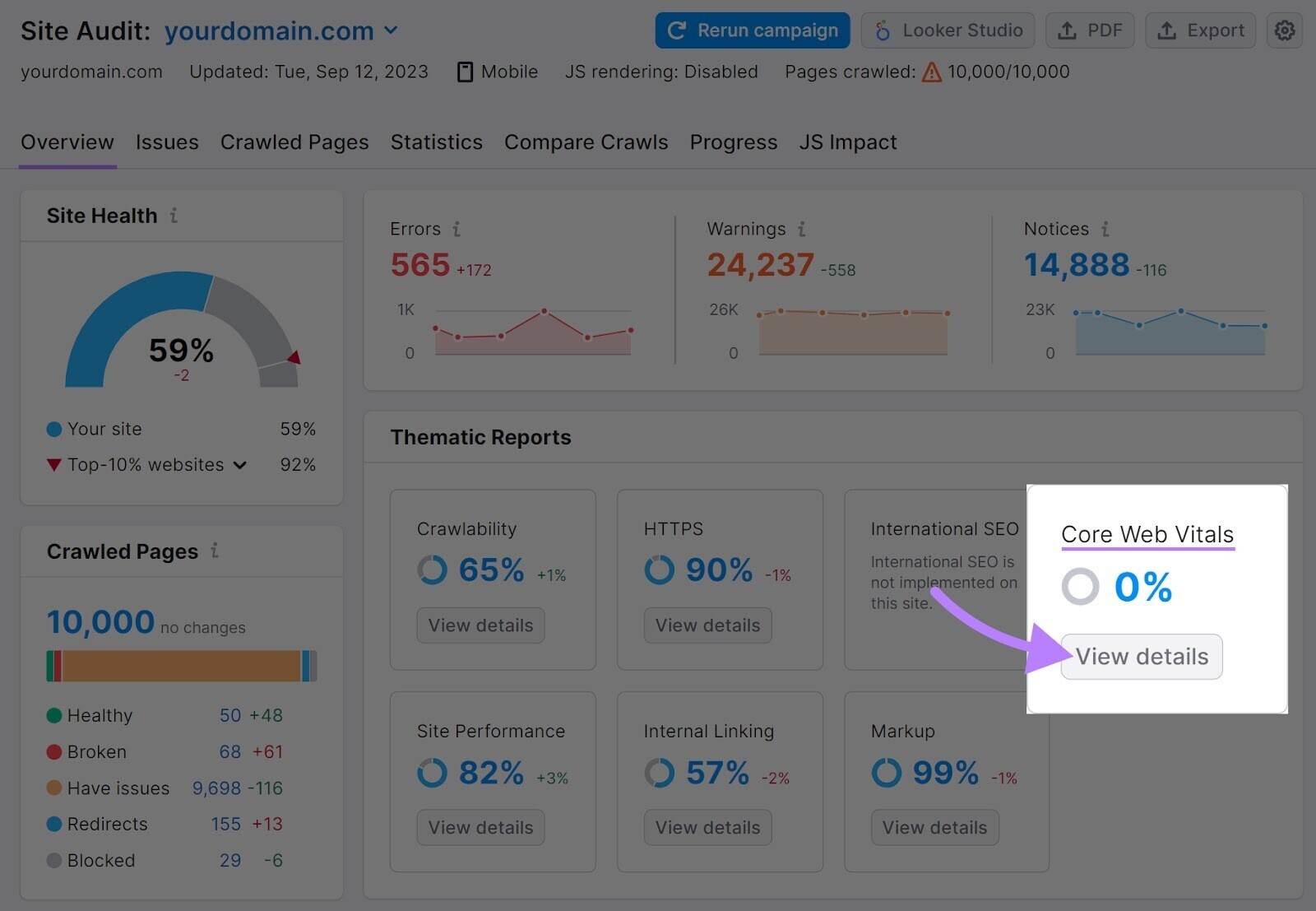
You’ll get an overview of your Core Web Vitals score. This metric measures how interactive, fast, and visually stable your site is for mobile crawlers.
Google recommends a good score for “success with Search” and an overall great UX.
You’ll also see a list of suggested improvements for specific pages.
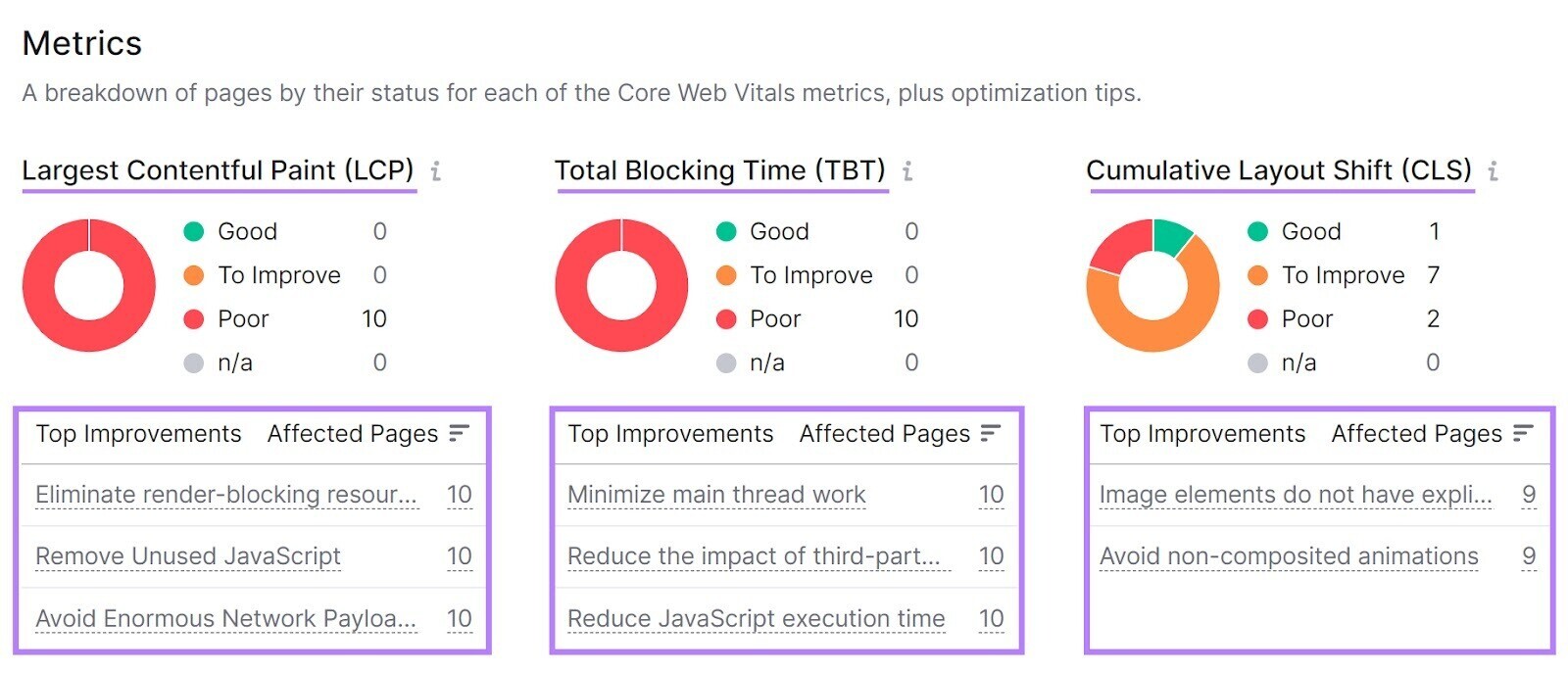
Fix these. Then, re-run your site and SEO audit to make sure everything works for mobile users.
8. Rich Results Test for Enhanced SERP Results
Rich Results Test is a free Google tool for SEO that ensures you’re set up to rank as a rich snippet in the SERPs.
A “rich snippet” is a search result that shows additional information.
Here’s an example:

Instead of plain text, Google includes an image, rating, vote count, and time estimate.
Use Google’s Rich Results Test to set up your structured data correctly. So the search engine can pull this information.
Simply paste a URL into the tool’s search bar and click “Test URL.”
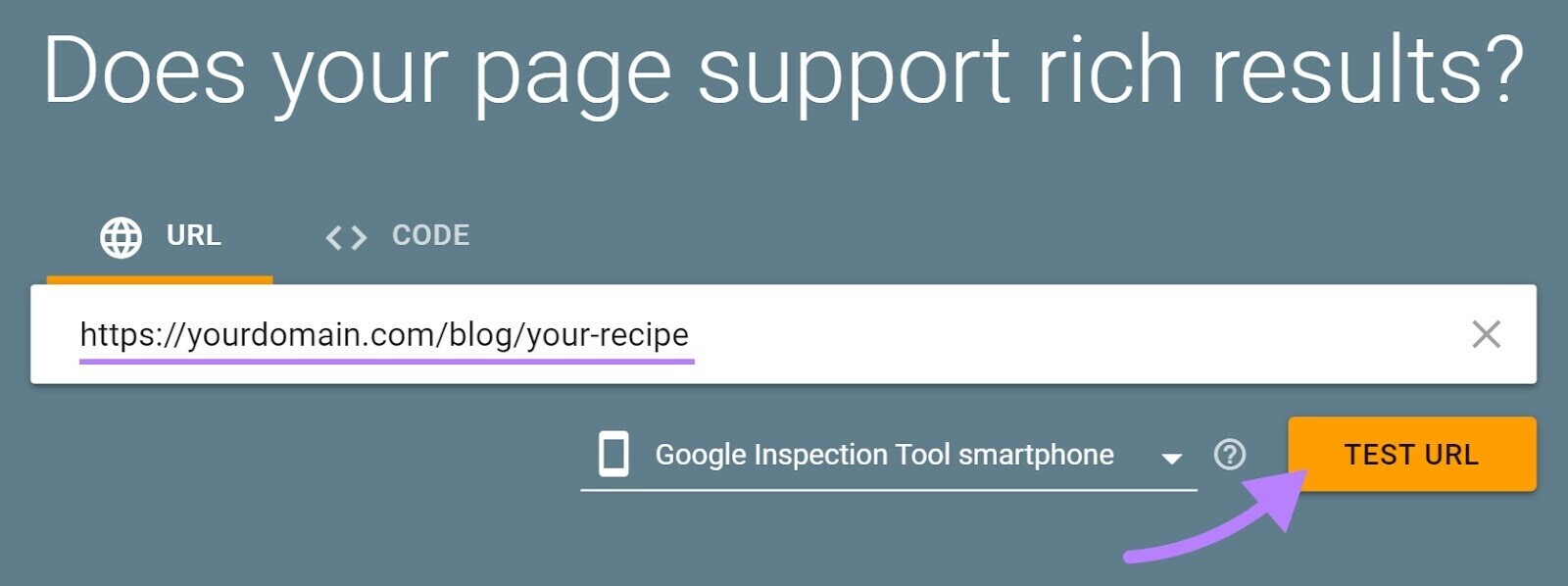
Under the “Detected Structured Data” section, the tool will show you what it found.
See a warning? Click on it for more details.

You’ll see invalid items that need fixing. Some “missing fields” are optional, but we recommend adding them to ensure you’re set up for rich snippets.
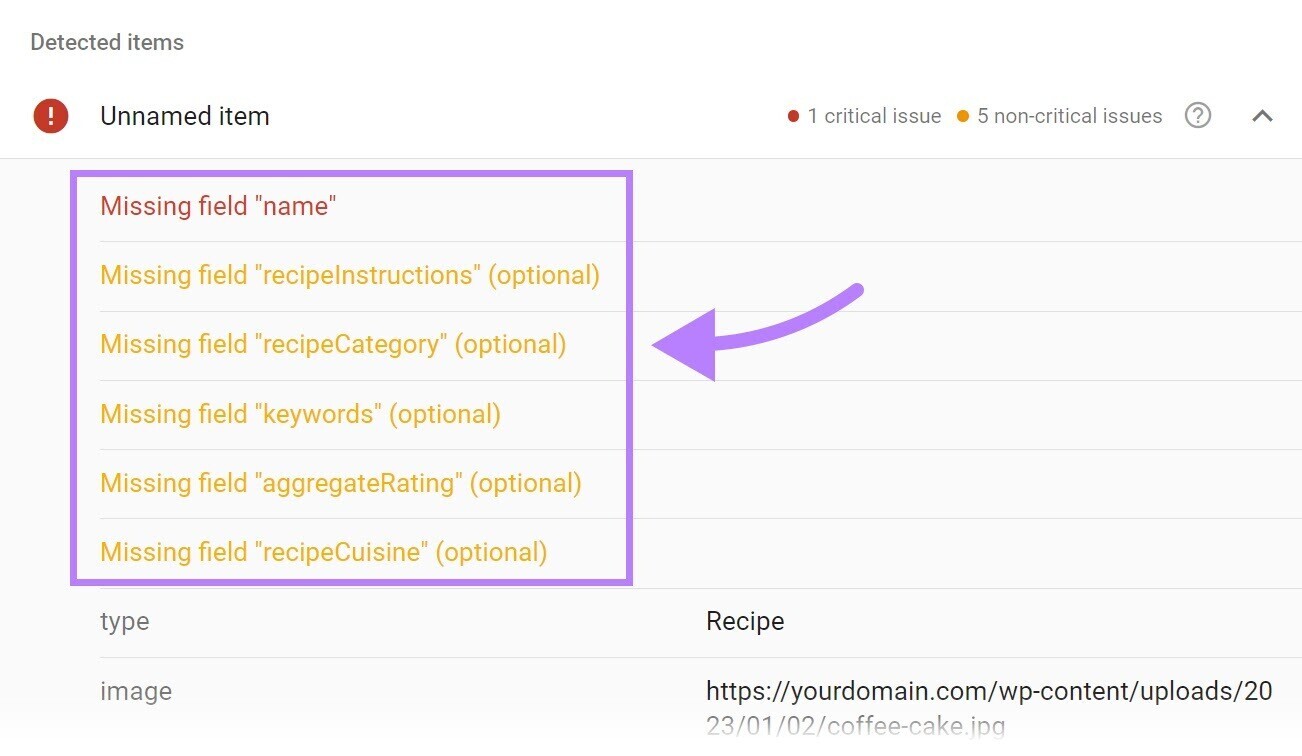
Our structured data shows the “name” field is missing on our recipe page. Fixing it will require adding one and specifying the recipe’s name in our code.
Going through this process gives you the best chance of ranking as a rich snippet. However, Google doesn’t guarantee it.
Google’s algorithm aims to show the most useful, relevant content to searchers. Sometimes, a text result may be more appropriate.
You can also combine the Site Audit tool with the Rich Results Test to uncover structured data and rich snippet issues.
On your Semrush dashboard, click “View details” under “Markup.”
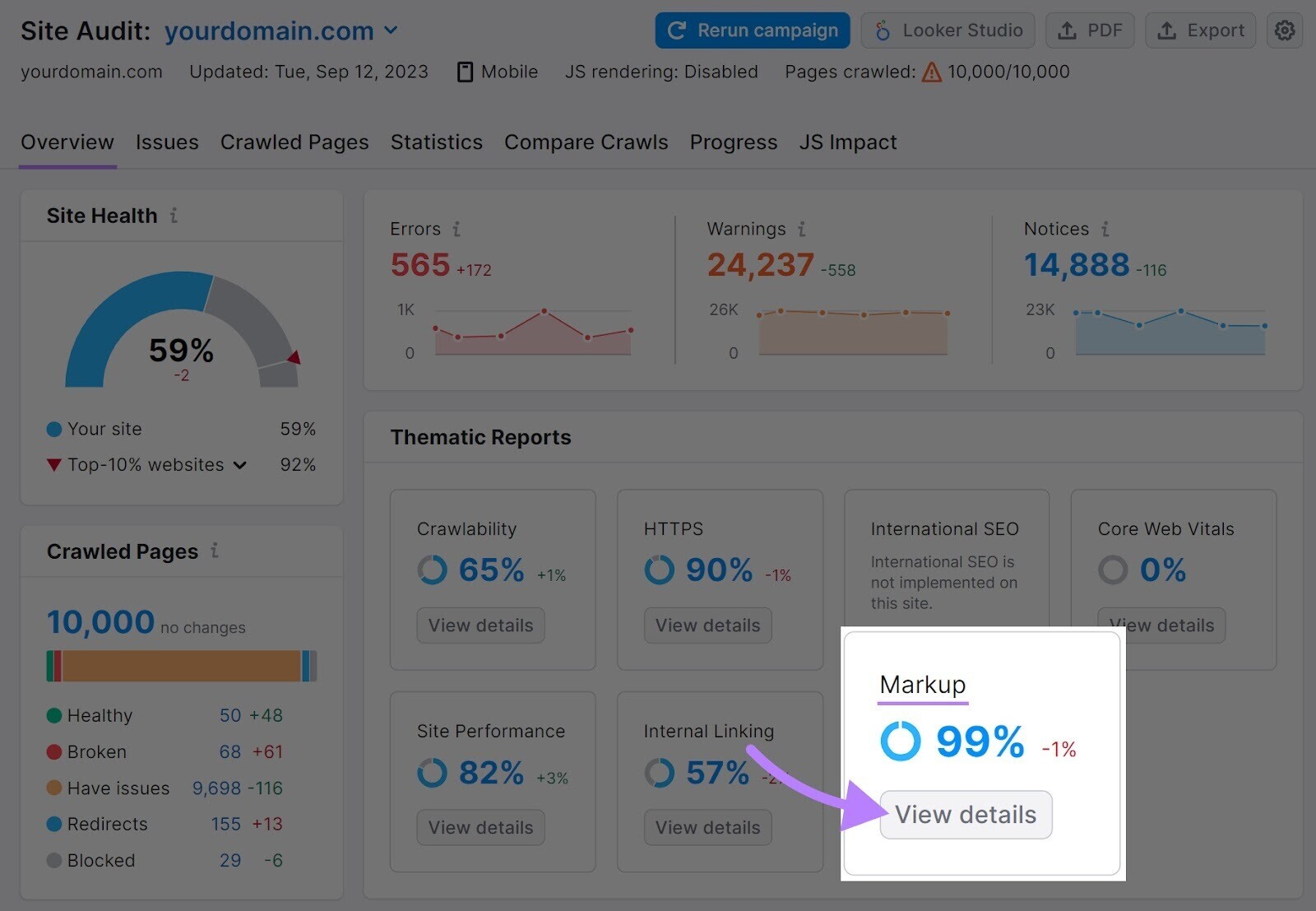
You’ll see your site’s pages divided into “with markup” and “no markup.” It will also tell you how many have invalid structured data.
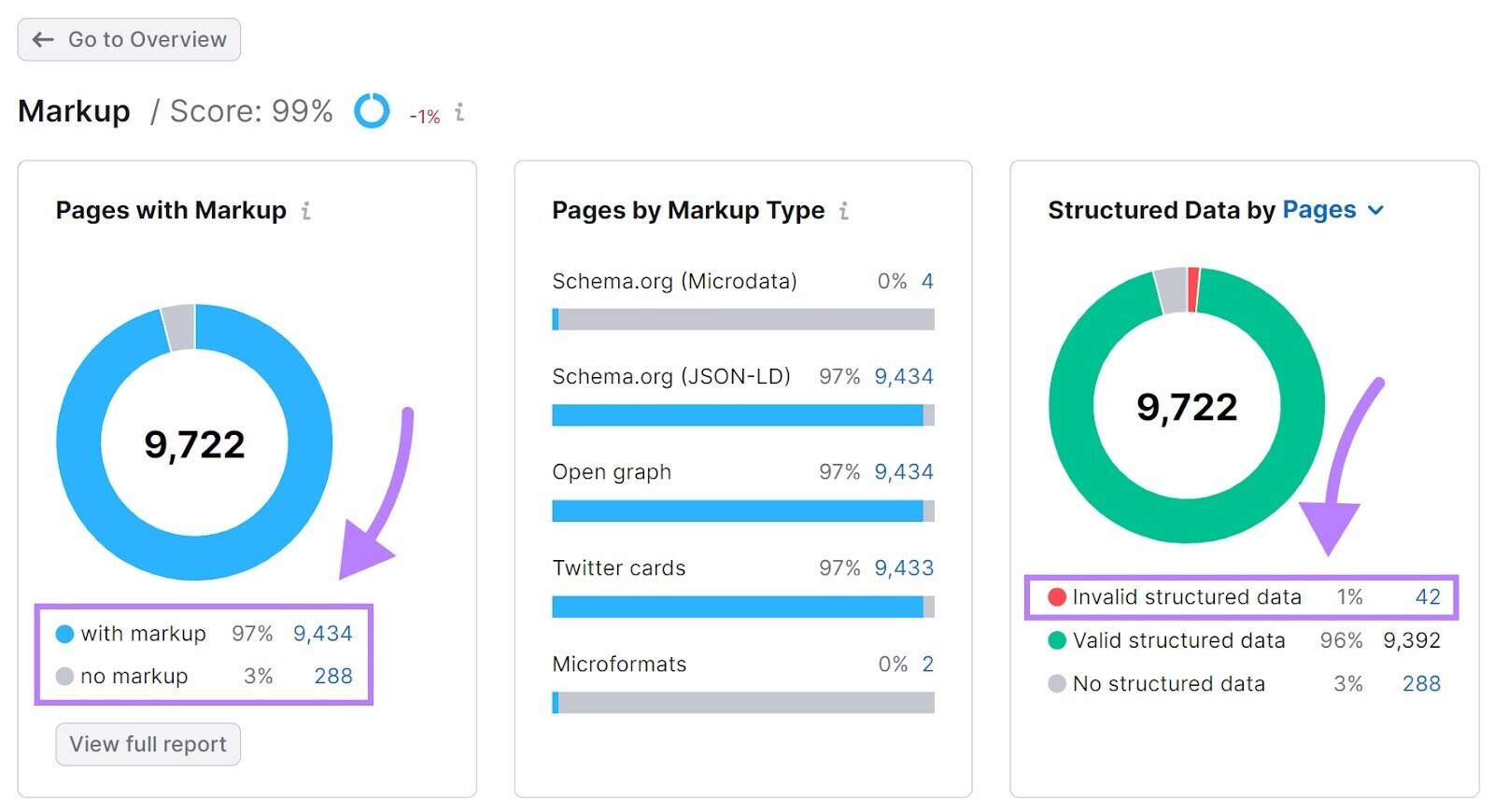
At the bottom of the report, click “View all invalid items” under the “Structured Data Items” widget.
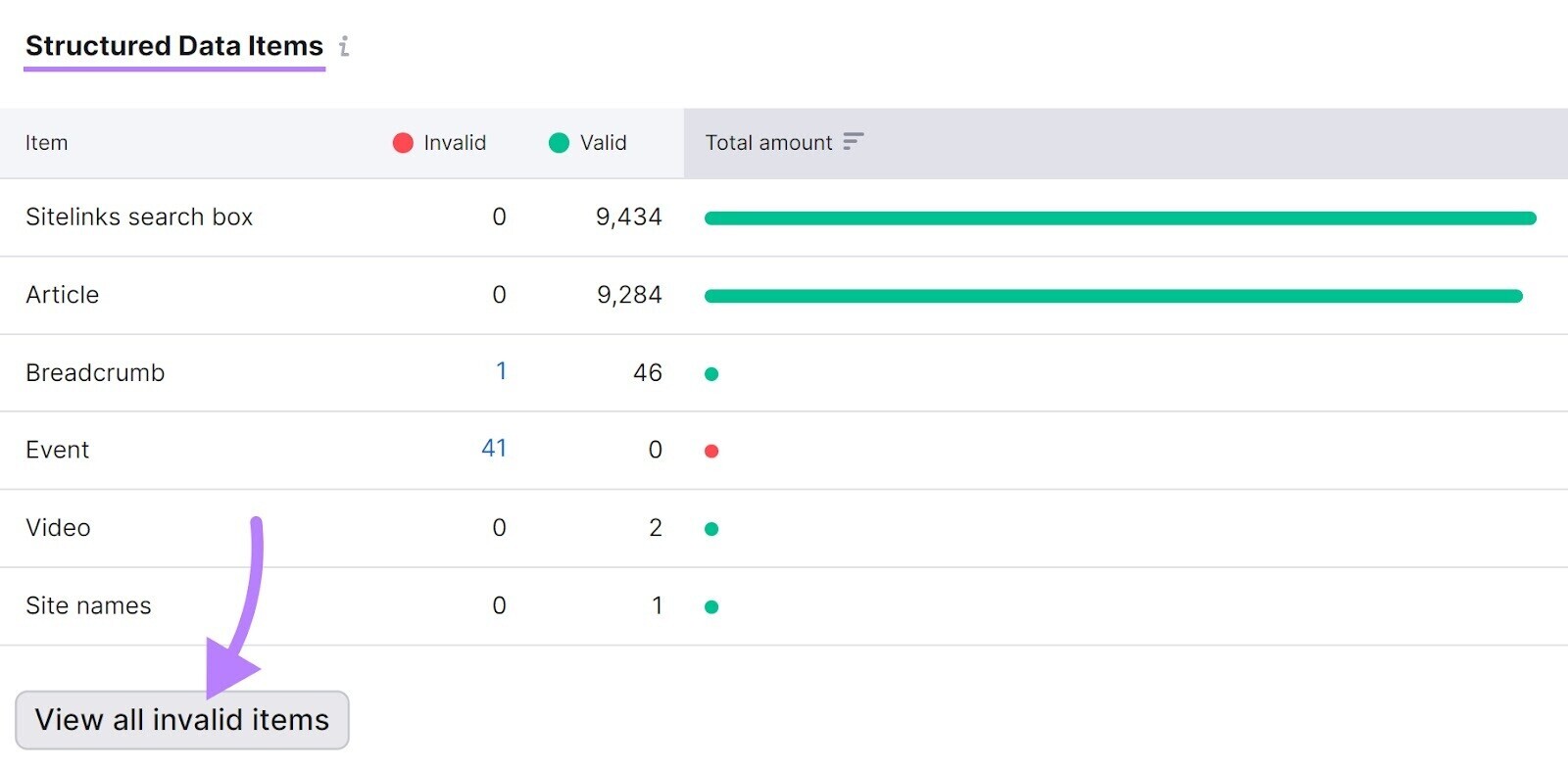
Click the tag button to open and test each page in Google’s Rich Results Test tool.
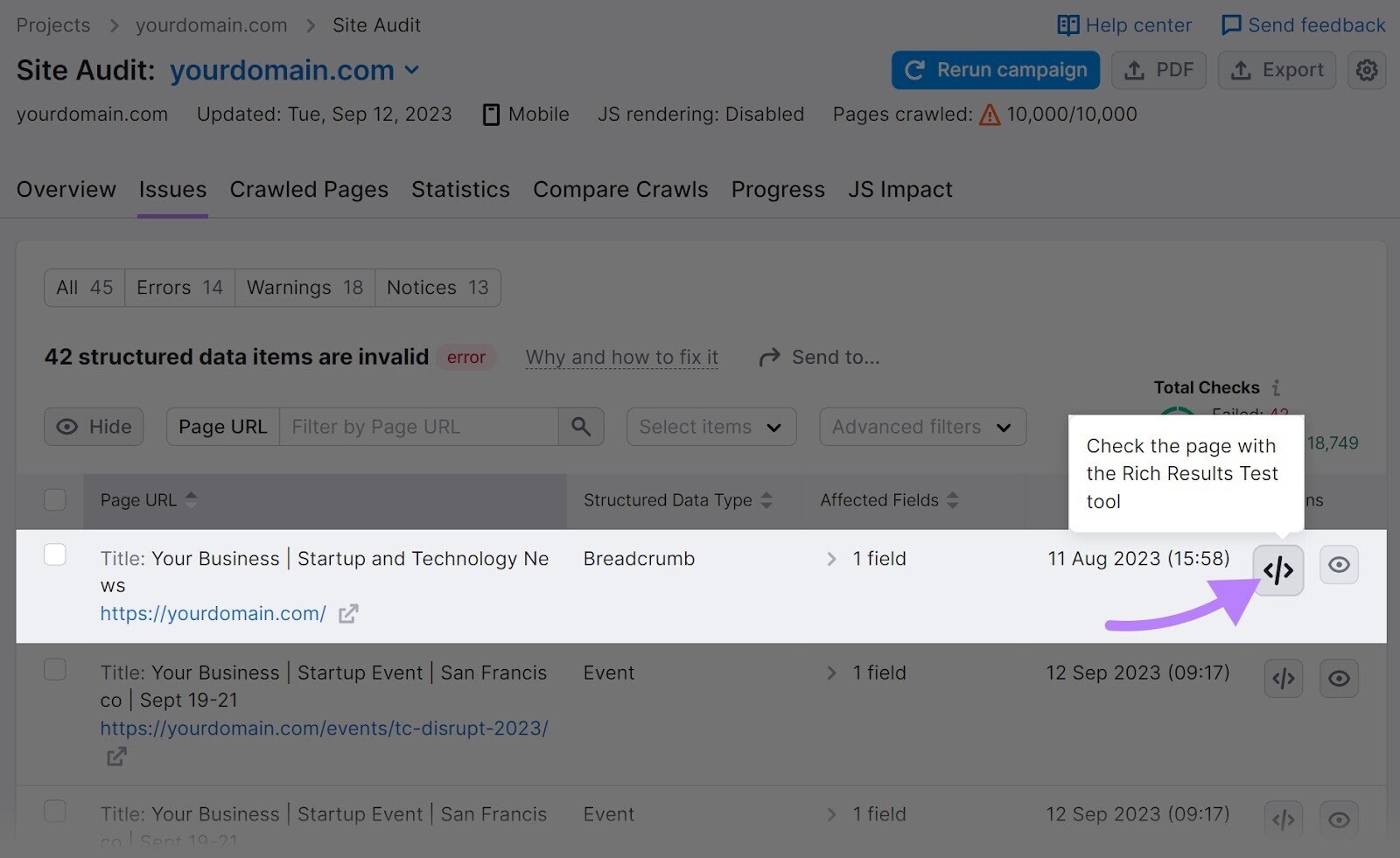
The test will start automatically. Be prepared to wait a minute or two.
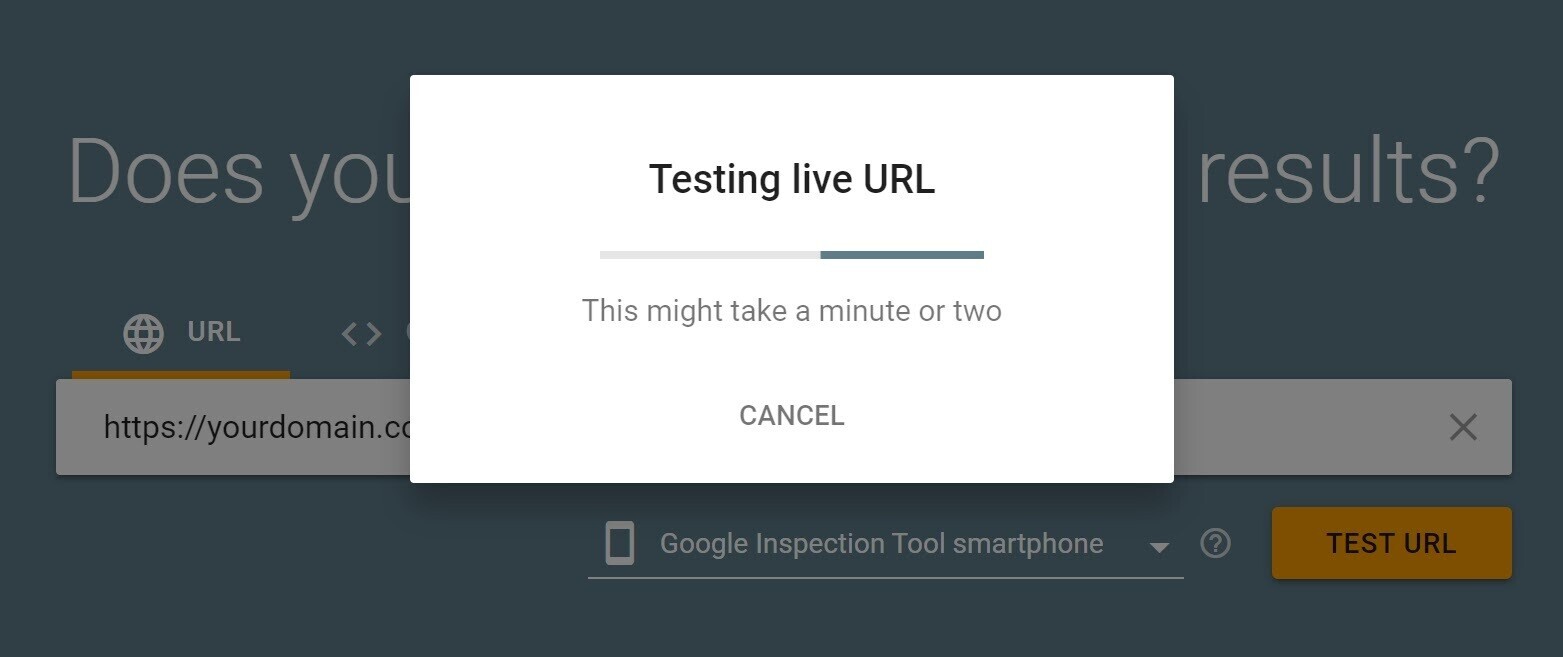
Next, view your results.

Valid results are eligible to feature as rich snippets. Proceed to fix any invalid items by following the instructions outlined above.
Remember: How your content is displayed in the SERPs is ultimately up to Google.
An Optimized Site Is the Basis of a Successful SEO Strategy
Each of the SEO Google tools above is free. Newbies and SEO experts alike can improve their strategies without spending a dime.
But learning and remembering several different tools can be overwhelming. Semrush’s Site Audit tool will guide you on how to maximize your website’s ranking and conversion potential—all in the same platform.
Source link : Semrush.com
